|
|

山口大学大学院 創成科学研究科 地球圏生命物質科学系専攻 化学コース
山口大学 理学部 生物・化学科 化学コース |
Functional Material Chemistry Laboratory
Graduate School of Science and Technology for Innovation, Yamaguchi University
Yamaguchi 753-8512, Japan
 |

|
|

<2023>
Kinetic Studies of WO3-Based Phoochromism in Polyvinyl Alcohol Film
Suzuko Yamazaki, Koki Isoyama
Langmuir 2023, 39, 10240-10248
DOI: 10.1021/acs.langmuir.3c01227

<2022>
Photochromism of TiO2 Nanoparticles Doped with Molybdenum Ions: Neutral Color Change from Colorless
to Black via Glay
Suzuko Yamazaki, Kohshiro Okimura
Langmuir 2022, 38, 48, 14827-14836
DOI: 10.1021/acs.langmuir.2c0248
Determination of W(V) in WO3 Photochromism Using Localized Surface Plasmon Resonance of Ag Nanoparticles
Suzuko Yamazaki, Koki Isoyama
J. Phys. Chem. B 2022, 126, 6520-6528
DOI: 10.1021/acs.jpcb.2c03253
| Kinetic Insights into Metaphosphoric Acid-Catalyzed Water-Crosslinking Reactions in Silane-Grafted Polyolefin System |
Shohei Tanaka, Kenta Adachi
Phosphorus, Sulfur, and Silicon and the Related Elements, 2022, 1-9, 848-856
DOI:10.1080/10426507.2022.2046573
Abstract: Polyphosphoric acid (PPA)-catalyzed water-crosslinking reaction in silane-grafted
polyolefin system was investigated. PPA exists as an equiliburium mixtere
comprising several phosphoric acid oligomers. Distributions of these oligomers
depends on the phosphorus pentoxide content(%P2O5) of the PPA. Our results revealed that the PPA presented a higher catalytic
activity than dibutyltin dilaurate, which is a catalyst most commonly used
in polymer industry. The difference in catalytic activities of PPAs was
primarily attributed to the distribution of the phosphoric acid oligomers
in PPA; as the degree of highly condensed phosphoric acid oligomers increased,
the catalytic activities of PPAs were enhanced. From the theoretical results,
we concluded that highly condensed oligomer could from the stable hydrate
via hydrogen bond with a water molecule, leading to the enhanced catalytic
activity of PPA for the hydrolysis reaction. This finding will add to the
understanding in the development of the highly active and eco-frendly catalysts
for the crosslinking reaction in polymer systems.
|
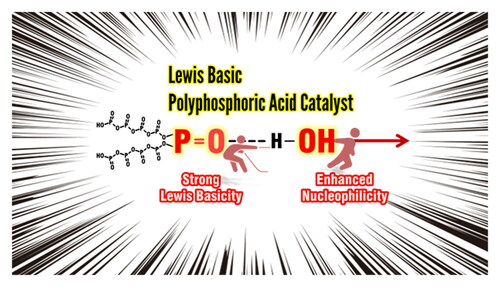 |
 |
| Enhancing Catalytic Activity of Copper(II) Complexes by Curcuminoid as
Electron-Withdrawing Ligand for Silane Water-Crosslinking Reaction:A join
Experimental and Theoretical Study. |
Shohei Tanaka, Mina Imamura, Kenta Adachi
J. Sol-Gel Sci. Technol., 2022, 102 , 322-334
DOI:10.1007/s10971-002-05773-5
| Abstract: The catalytic performances of several copper(II) β-diketonate(Cu(II)βDiK)2) complexes for the water-crosslinking reaction in the 3-methacryloxypropyltrimethoxysilane-grafted
ethylene-propylene copolymer (EPR-g-MTMS) system were investigated. UV-vis
spectroscopic measurements demonstrated the curcuminoids could strongly
ccordinate with nanorods copper(II) ion. Moreover, results of the kinetic
examination revealed the good linear relationship between the stability
constants and hydrolysis activation energies in the Cu(II)(βDiK)2 catalyzed EPR-g-MTMS system, suggesting, the stability of Cu(II)(βDiK)2complex was a very good catalytic activity predictor. The theoretical calculations
demonstrated that the electron-withdrawing curcuminoids pulled the electron
density from Cu2+ center to from the stable complex and decreased water-dissociation energy
of axially coordinated water mlecules with copper(II) ion. The results
clearly show the β-dikatone ligands affect the water-exchange reaction
of copper(II) ion, resulting in the enhanced catalytic activities of Cu(II)(βDiK)2 complexes for the silane water-crosslinking reaction. Our results provide
a promising potential to use metal-curcuminoids in the room-temperature-vulcanizing
silicone rubber applications. |
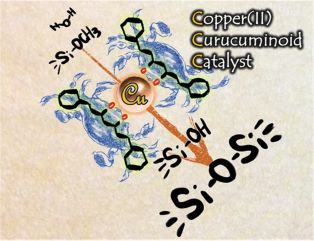 |
 |
| Multistep photochromism by using photoinduced redox reaction in tungsten
oxide colloidal solution containing Cu(II) ion |
Koki Isoyama, Seiji Tani, Suzuko Yamazaki
Colloids and Surfaces A, 2022, 635, 128060
DOI:10.1016/j.colsurfa.2021.128060
<2021>
| One-Pot Synthesis of Long Rutile TiO2 Nanorods and Their Photocatalytic Activity for O2 Evolution: Comparison with Near-Spherical Nanoparticles |
Suzuko Yamazaki, Masanari Kutoh, Yukari Yamazaki, Nanami Yamamoto, and Mamoru Fujitsuka
ACS Omega, 2021, 6 , 31557-31565
DOI:10.1021/acsomega.1c04003
| Porous TiO2 adsorbed with squaraine dye as visible-light-responsive photocatalystf |
Suzuko Yamazaki, Kotoe Sonoda, Kiyotaka Maruoka, Yukari Yamazaki, Hiroshi Naragino, Kensuke
Honda, Toshihiro Murafuji, Michinori Sumimoto
J. Photochem. Photobiol. A: Chem., 2021, 421, 113543
DOI:10.1016/j.jphotochem.2021.113543
<2020>
| The formation mechanism of ZnTPyP fibers fabricated by a surfactant-assisted
method |
Keigo Tashiro,Toshihiro Murafuji, Michinori Sumimoto, Mamoru Fujitsuka,
Suzuko Yamazaki
New J. Chem., 2020, 44 , 13824-13833
DOI:10.1039/d0nj02829k
| Visualization of ultraviolet irradiation using WO3-cellulose derivatives composite film |
Suzuko Yamazaki, Koki Isoyama, Dai Shimizu
Optical Materials 106 (2020) 109929
DOI:10.1016/j.optmat.2020.109929
| Visible light responsive TiO2 photocatalysts for degradation of indoor acetaldehyde |
Suzuko Yamazaki, Keisuke Kozasa, Koshiro Okimura, Kensuke Honda
RSC Adv., 2020, 10, 4193-41402
DOI:10.1039/dr0ra07567a
<2019>
| Fast Evaluation of Potential Synthesis Routes Using Transition State Detabase(TSDB) |
Kenji Hori, Aki Hasegawa, Noriaki Okimoto, Suzuko Yamazaki
Journal of Computer Aided Chemistry, Vol.20, 50-55 (2019)
DOI:10.2751/jcac.20.50
| Effect of Organic Additives during Hydrothermal Syntheses of Rutile TiO2 Nanorods for Photocatalytic Applications |
Yukari Yamazaki, Mamoru Fujitsuka, Suzuko Yamazaki
ACS Appl. Nano Mater. 2019, 2, 9, 5890-5899
DOI: 10.1021/acsanm.9b01334
| Abstract: TiO2 nanorods have been widely investigated for various applications as
catalyst support, photoanode, bioanalytical platform, and photocatalyst
because of their unique properties due to the high length-to-width ratio.
In this study, we examined the effect of eight organic additives for the
hydrothermal synthesis and clarified that α-hydroxy acids are good structure
directing agents to synthesize rutile TiO2 nanorod. Depending on the structure of the α-hydroxy acid used for
the synthesis, i.e., glycolic acid (GA), lactic acid (LA), and 2-hydroxyisobutyric
acid (2-HIBA), the length and the width of the nanorod are varied. Under
the hydrothermal treatment of 200 °C for 12 h, small particles consisting
of anatase and brookite or anatase particles coexist surrounding the rutile
nanorod synthesized with LA or 2-HIBA, respectively, whereas GA yields
only rutile nanorod. With increasing hydrothermal time, nanoparticles surrounding
the nanorod disappear and 100% rutile nanorod is synthesized with LA for
96 h (TiO2_LA_96h) or 2-HIBA for 48 h (TiO2_2-HIBA_48h). For these 100% rutile nanorods synthesized with GA, LA, and 2-HIBA, the shape of quadrangular prism with nonflat ends is observed. The selected area electron diffraction patterns indicate that the crystal growth occurs in the [001] direction and the side or the end surface of the nanorods is attributable to {110} or {111} facet, respectively. The photocatalytic activity for the oxygen evolution through water oxidation is in the following order: TiO2_GA_12h > TiO2_LA_96h > TiO2_2-HIBA_48h. Time-resolved diffuse reflectance spectra suggest that the
highest photocatalytic activity obtained with TiO2_GA_12h is attributable to the rapid decay of the photogenerated electrons
to the deep trapping sites. Our results indicate that GA is the most appropriate
as the structure directing agent to synthesize rutile TiO2 nanorod because of the shortest hydrothermal time and the highest
photocatalytic activity. |
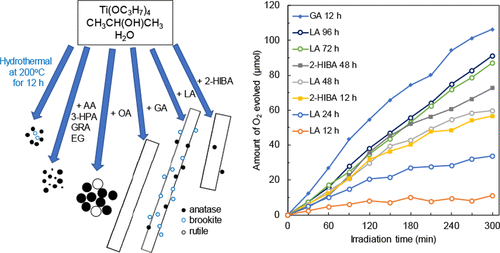 |

| A novel efficient catalyst for water-crosslinking reaction of silane-grafted polyolefin system: Specific influence of axially coordinated n-alkylamine ligand on catalytic abilities of metal acetylacetonate complex |
S. Tanaka, K. Adachi
DOI:10.1016/j.mtcomm.2019.100584
| Abstract: Catalytic activities of the novel acid-base hybrid catalyst on the water-crosslinking
reaction (hydrolysis and condensation) of 3-methacryloxypropyltrimehoxysilane-grafted
ethylene-propylene copolymer (EPR-g-MTMS) were investigated by means of
attenuated total reflectance-Fourier transform infrared (ATR-FTIR) and
gel fraction measurements. We have synthesized RNH2-M(acac)2 complex as
an acid-base hybrid catalyst which shows the high catalytic activities
for water-crosslinking reaction in EPR-g-MTMS system. It is noted that
the catalytic activity of RNH2-M(acac)2 complex clearly shows dependence
on axially coordinated n-alkylamine compounds in hydrolysis reaction, meanwhile,
the center metal ion in RNH2-M(acac)2 complex affects on the catalytic
activities for overall water-crosslinking reaction in this study. The design
concept of an acid-base hybrid catalyst showed bifunctional catalytic activity
for the water-crosslinking reaction in the alkoxysilane-grafted polyolefin
system. |
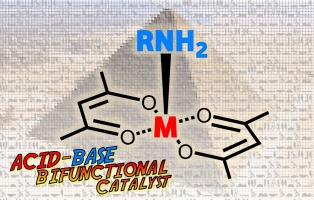 |

| Photocatalysis of ZnTPyP Fibers Fabliicated by Surfactant-Assisted Method:
Effect of Surfactant and Kinetic Studies |
K. Tashiro, S. Yamazaki
Colloids and Surfaces A, 2019, 580, 123741
DOI : 10.1016/j.colsurfa.2019.123741
| Abstract: We fabricated 5,10,15,20-tetra(4-pyridyl)porphyrinatozinc(II) (ZnTPyP)
fibers by utilizing surfactant-assisted method with cetyltrimethylammonium
bromide (CTAB). The ZnTPyP fibers became longer as molar ratio of CTAB
to ZnTPyP (γ) increased. In the case of γ ≥ 50, the Soret band of ZnTPyP
monomer was observed after stirring for 1 h and was split into two peaks
after the aging at 40 °C for more than 5 days. On the other hand, such
split peaks were observed without the aging when the γ value was 10 or
20. These findings suggest that CTAB interacts with the ZnTPyP monomer
in aqueous solution to form micelles, and the fibers are gradually constructed
by self-assembling the stabilized ZnTPyP monomer. Photocatalytic activity
of the ZnTPyP fibers was evaluated for the degradation of rhodamine B (RhB)
in water under visible light (VL) irradiation. The highest photocatalytic
activity was obtained at γ = 150 - 300, indicating that the fibers with
1.3 - 2.0 µm were the most suitable as photocatalyst. When air was bubbled
in the reaction solution, the photocatalytic activity was higher than that
under N2bubbling. However, absorption peak attributed to the ZnTPyP fibers decreased under air bubbling although it remained almost constant under N2 bubbling. These results suggest that the ZnTPyP fibers can act as photocatalyst
and active oxygen species such as O2•− radical might decompose the ZnTPyP fibers. Kinetic studies were performed to clarify the degradation mechanism of RhB under the experimental condition where the decomposition of the ZnTPyP fibers was negligible. |
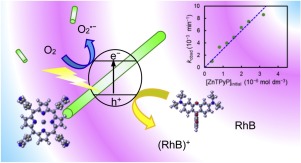 |

| Photocatalytic degradation of gaseous trichloroethylene on porous titanium
dioxide pellets modified with copper(II) under visible light irradiation |
K. Tashiro, T. Tanimura, S. Yamazaki
J. Photochem. Photobiol. A: Chem., 2019, 377, 228–235.
DOI : 10.1016/j.jphotochem.2019.03.037
| Abstract: Porous titanium dioxide pellets modified with copper(II) ion (Cu-TiO2) were synthesized by sol-gel method with dialysis for photocatalytic
degradation of gaseous trichloroethylene (TCE) under visible light (VL)
irradiation. TCE was completely degraded by passing the gas stream (mole
fractions of oxygen and TCE were 0.2 and 1.75 × 10−4, respectively) at
the flow rate of 25 mL min−1 through 0.2 g of the Cu-TiO2 pellets
(Cu content: 0.1 atom%) calcined at 200 °C. TCE was converted mainly to
carbon dioxide, dichloroacetic acid (DCAA), and inorganic chlorine species.
Relatively small quantities of pentachloroethane (PCA) and trichloroacetaldehyde
(TCAH) were detected as products on the Cu-TiO2 surface. Comparison
with porous TiO2 pellets under ultraviolet irradiation revealed that
more chlorinated products and less carbon dioxide were formed on Cu-TiO2 under
VL irradiation. The mineralization of TCE to carbon dioxide was calculated
to be only ca. 30.0%. It is noted that DCAA, PCA and TCAH were accumulated
on the surface and were extracted with ethyl acetate. The porous Cu-TiO2 pellets show promise as the photocatalyst acting under VL irradiation
for converting TCE gas to chlorinated compounds which can be used in industries.
|
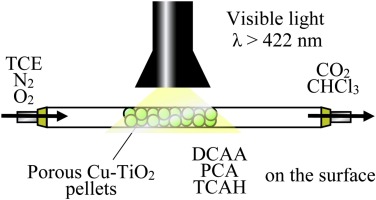 |

<2018> 
| Morphological Analysis of Self-assembled Structures of Merbromin Molecules
Adsorbed on Titanium(IV) Oxide Nanoparticles |
K. Adachi, N. Tsuru
Bunseki Kagaku, 2018, 67, 719-726.
DOI : 10.2116/bunsekikagaku.67.719
| Abstract: Abroad understanding of the adsorption and aggregation behavior of organic
dye molecules on an inorganic semiconductor surface provides a new strategy
for optical and electronic devices. We chose merbromin (Merb) and titanium(IV)
oxide (TiO2) colloids in this study. The adsorption and aggregation behavior of Merb
in a TiO2 colloid aqueous solution were spectrophotometrically investigated. The
absorption spectra of Merb were significantly red-shifted in the visible
region upon the addition of a TiO2 colloid solution. Detailed spectral analysis based on Kasha's exciton
coupling theory and a modified Langmuir adsorption model revealed that
dianionic Merb molecules are adsorbed flat on a positively charged TiO2 colloid surface by an electrostatic interaction, and eventually from "oblique"
J-type dimers aligned in a head-to-tail fashion. We envisage new applications
of this analysis in the development of advanced dye-sensitized solar cells,
where the adsorption/aggregation morphology of organic dyes on the metal
oxide is a crucial factor to be considered. |
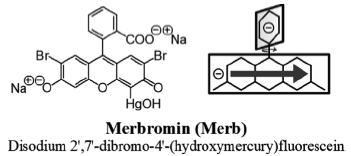 |

| Developing Active TiO2 Nanorods by Examining the Influence of Morphological Changes from Nanorods to Nanoparticles on Photocatalytic Activity |
Y. Yamazaki, K. Azami, R. Katoh, S. Yamazaki
ACS Appl. Nano Mater., 2018, 1, 5927-5935.
DOI : 10.1021/acsanm.8b01617
| Abstract:We synthesized rutile TiO2 nanorods with high crystallinity, i.e., degree of crystallinity greater than ca. 90%, by using a hydrothermal method and studied the effect of the morphological change from rod shape to subsphere by the subsequent thermal treatment. The photocatalytic activity was estimated for O2 evolution from water oxidation because this reaction was hardly affected by the specific surface area of photocatalysts. Thermal desorption and gas chromatography-mass spectrometry measurements suggested the decomposition of residual glycolic acid in TiO2 nanorods at 272 and 590 °C. Observation with scanning electron microscopy and physical properties such as specific surface area and crystallite size indicated deformation of the rod shape to subsphere by the calcination above 600 °C. Time-resolved microwave conductivity measurements have revealed that the TiO2 nanorods possess the longest lifetime of photogenerated electrons among all samples. However, the O2 evolution rate of the TiO2 nanorods was much lower than subsphere TiO2 obtained by calcination at 800 °C (TiO2-800). Photodeposition of Pt and PbO2 showed that the oxidation and the reduction sites were separated on TiO2-800 whereas their deposition distributed uniformly on the TiO2 nanorods. The Pt loading on the surface of the TiO2 nanorods increased the O2 evolution rate whereas that on TiO2-800 was hardly affected, indicating that the Pt loading enhances the charge separation on the surface of the TiO2 nanorods. Therefore, the lower photocatalytic activity of the TiO2 nanorods is ascribed to the recombination process on the surface. The suppression of the recombination on the surface and thereby the utilization of the long lifetime of the photogenerated electrons is the key factor to develop superior TiO2 nanorods for photocatalysis. |
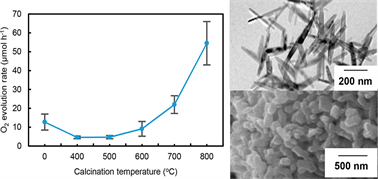 |

| Factors affecting photocatalytic activity of visible light-responsive titanium
dioxide doped with chromium ions |
N. Nishiyama, K. Kozasa, T. Okajima, M. Fujitsuka, T. Majima, S. Yamazaki
Catal. Sci. Technol., 2018, 8, 4726-4733.
DOI : 10.1039/c8cy01411f
| Abstract: Titanium dioxide doped with Cr ions (Cr-TiO2) was synthesized by a sol-gel method, with only water as the solvent,
and dialysis. For Cr-TiO2 sintered at 200 °C, ca. 90% of 4-chlorophenol (4-CP) was degraded at Cr
doping amounts of 0.68–1.3 atom% under visible light irradiation. At doping
amounts above 1.7 atom%, the 4-CP degradation ratio increased for Cr–TiO2 sintered at 300–500 °C. X-ray photoelectron spectroscopy and X-ray absorption
near edge structure measurements showed that only Cr(III) was present on
the surfaces of Cr–TiO2 samples sintered at 200 or 400 °C and some of the Cr(III) in the bulk
was oxidized to Cr(VI) by sintering at 400 °C. The 4-CP degradation was
enhanced with increasing Cr(VI)/Cr(III) ratio in the bulk, suggesting the
spatial separation of Cr(III) on the surface under visible light irradiation:
electrons are excited from Cr(III) to the conduction band of TiO2 and then trapped at the doped Cr(VI) whereas the photogenerated Cr(IV)
oxidizes 4-CP. Time-resolved diffuse reflectance spectroscopy was used
to evaluate the lifetimes of the photogenerated electrons. The highest
photocatalytic activity was obtained with ca. 0.8 atom% Cr–TiO2 sintered
at 200 °C. This high activity is ascribed to the presence of oxygen vacancies,
which act as electron-trapping sites. |
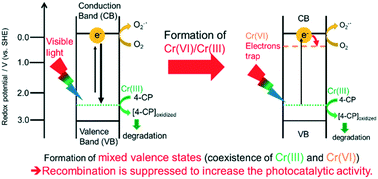 |

| Effect of Dispersants on Photochromic Behavior of Tungsten Oxide Nanoparticles
in Methylcellulose |
S. Yamazaki, D. Shimizu, S. Tani, K. Honda, M, Sumimoto, K, Komaguchi
ACS Appl. Mater. Interfaces, 2018, 10, 19889-19896.
DOI : 10.1021/acsami.8b04875
| Abstract: Tungsten oxide-based photochromic films which change reversibly in air
between colorless-transparent in the dark and dark blue under UV irradiation
were prepared by using methylcellulose as a film matrix and various dispersants.
Alpha-hydroxyl acid like glycolic acid (GA) or glyceric acid (GlyA) is
the best dispersant because it can make the film transparent by adding
a small quantity much less than that of 3-hydroxypropionic acid or ethylene
glycol. Fourier-transform infrared spectra and Raman spectra indicate that
a strong interaction exists between WO3 and GA or GlyA. The coloration and bleaching processes of the prepared
films were investigated to clarify the effect of the dispersants and the
moisture contents. The bleaching rate remarkably decreased in the films
containing GA or GlyA but accelerated by increasing the contact with O2. Measurements of electron spin resonance reveals that GA and GlyA as dispersants
stabilize the W5+ state. This paper shows that the coloring rate and the period for keeping
the blue-colored state are tunable by changing the dispersants. The photochromic
films containing α-hydroxyl acid as the dispersant have potential for application
as rewritable film on which information displayed with blue-colored state
can be clearly readable for longer times compared with other dispersants. |
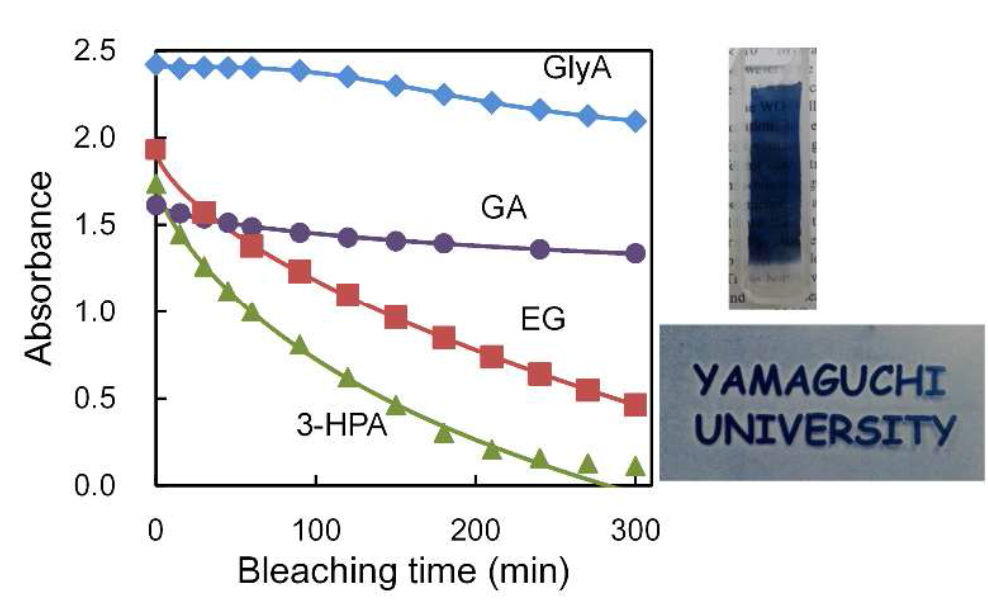 |

| Stimuli-Triggered Reversible Switching Mechanism between H- and J-Type
Supramolecular Assemblies of Cationic Porphyrins Adsorbed on Tungsten(VI)
Oxide Surface |
K. Adachi, Y. Ura, N. Kanetada
J. Porphyrins Phthalocyanines, 2018, 22, 658-669.
DOI : 10.1142/S1088424618500372
| Abstract: Supramolecular organic dye–inorganic semiconductor nanocrystal assemblies are potentially useful in a broad range of technologies and applications, including photovoltaic systems, but the molecular basis of the adsorption of dye molecules onto the semiconductor surfaces remains poorly understood. Herein, we investigated the pH-dependent adsorption and conformational change of two cationic porphyrin stereoisomers [5,10-diphenyl-15,20-di(N-methyl-4- pyridyl)porphyrin (cis-DMPyP) and 5,15-diphenyl-10,20-di(N-methyl-4- pyridyl)porphyrin (trans-DMPyP)] on the tungsten(VI) oxide (WO3) colloid nanoparticle in aqueous media by means of UV-vis absorption spectroscopy. In accordance with the combination of a modified Langmuir adsorption model and Kasha’s exciton coupling model, the molecular orientation and stacking arrangement of DMPyP derivatives on the WO colloid surface are discussed in detail. In the trans-DMPyP/WO3 aqueous system, trans-DMPyP molecules adopted flat-on orientation with respect to the WO colloid surface and eventually formed head-to-tail J-dimers regardless of pH conditions. cis-DMPyP molecules in the acidic system also lay flat-on and mainly formed H-dimers on the WO3 colloid surface, whereas ones in the neutral system exhibited a dominant edge-on orientation and had a higher tendency to form face-to-face H-dimers. Additionally, we have also convincingly demonstrated the pH-triggered switchable π-stacking geometry of cis-DMPyP molecules from H- to J-dimer and vice versa on the WO3 colloid surface. Such findings will undoubtedly provide a pertinent guideline for the rational design of stimuli-responsive organic-inorganic materials. |
 |

<2017>
| Effect of Mixed Valence States of Platinum Ion Dopants on the Photocatalytic Activity of Titanium Dioxide under Visible Light Irradiation |
N. Nishiyama, S. Yamazaki
ACS Omega., 2017, 2, 9033-9039.
DOI : 10.1021/acsomega.7b01393
| Abstract: Titanium dioxide doped with Pt ion (Pt-TiO2) was synthesized by a sol-gel method
using only water as solvent and conducting dialysis. The photocatalytic activity for the degradation of 4-chlorophenol (4-CP) on Pt-TiO2 was not affected by the Brunauer-Emmett-Teller specific surface area under visible light (VL) irradiation.
X-ray photoelectron spectroscopy (XPS) and X-ray absorption near edge structure measurements revealed that only Pt(IV) ion existed in the TiO2 bulk and both Pt(II) and Pt(IV) were present near the Pt-TiO2 surface. Pt(IV) is most likely substituted in the Ti(IV) site of TiO2 lattice due to their similar ionic sizes. Quantitative analysis of Pt(II) was performed in the XPS measurements, indicating that the amount of Pt(II) on the surface increased with
an increase in the doping amount from 0.2 to 1.0 atom%. We synthesized 0.5 atom% Pt-TiO2 with various Pt(II)/Pt(IV) ratios by changing the Ti(OC3H7)4 concentration used in the sol-gel synthesis.
The 4-CP conversion on Pt-TiO2 increased linearly with an increase in the Pt(II)/Pt(IV) ratios. Similar relationship was obtained with Pt-TiO2 which was prepared by a conventional sol-gel method in ethanol-water mixed solvent.
Therefore, the Pt(II)/Pt(IV) ratio is a key factor affecting the photocatalytic activity of Pt-TiO2 under VL irradiation. Our results indicate that controlling the mixed valence states of the doped metal ions is a new strategy to develop
highly active metal-ion-doped TiO2 under VL irradiation.
|
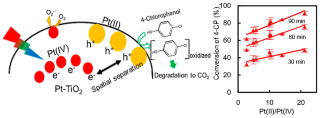 |

| Label-free Colorimetric Sensing of α-Amino Acids Based on Surface-enhanced
Photochromic Phenomena of Molybdenum(VI) Oxide Nanoparticles |
A. Yamamoto, K. Adachi
Bunseki Kagaku., 2017, 9, 639-646.
DOI : 10.2116/bunsekikagaku.66.639
| Abstract: Due to the biological importance of α-amino acids and their derivatives,
the development of novel colorimetric probes for these molecules has been
an active research area in recent years. In this study, surface-enhanced
photochromic phenomena by various α-amino acids (L-aspartic acid [Asp],
L-leucine [Leu], and L-lysine [Lys]) adsorbed on molybdenum(VI) oxide (MoO3) nanoparticles in an aqueous system were investigated by means of UV-vis
absorption spectrometry. No derivatization of α-amino acids is required,
and eventually highly accurate determinations are obtained from the UV-induced
MoO3 photochromic coloration. Under optimal conditions in this system, limit
of quantitation (LOQ) values of 3.45×10−6, 2.08×10−6, and 1.53×10−6 mol dm−3 for Asp, Leu, and Lys, respectively, were achieved at pH 2. During UV
irradiation, the detection process could be visually observed by naked
eyes. A simple and unique approach to explore sensitive "label-free"
colorimetric sensing toward α-amino acids is proposed. |
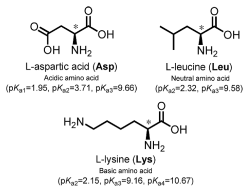 |

| Photocatalytic Degradation of Trichloroethylene on Platinum Ion-Doped TiO2 under Visible Light Irradiation |
T. Seyama, T. Tanimura, K. Tashiro, S. Yamazaki
Res. Chem. Intermed., 2017, 43, 5025-5039.
DOI : 10.1007/s11164-017-3051-z
| Abstract: Porous platinum ion-doped TiO2 (Pt–TiO2) was prepared by a sol–gel method and demonstrated to have superior photocatalytic
activity for the photodegradation of gaseous trichloroethylene (TCE) under
visible light (VL) irradiation from a xenon lamp equipped with 422-nm cut-off
filter. Kinetic studies were performed to clarify the effect of the doping
amounts, space times, VL intensity, and mole fractions of TCE, O2, and H2O on the degradation of TCE. Under ultraviolet (UV) irradiation, the photocatalytic
activity of Pt–TiO2 was the same as that of TiO2, indicating that the doped Pt ion did not act as a recombination center for the photogenerated holes and electrons. Based on the kinetic data and reaction products, we conclude that the photocatalytic degradation of TCE on Pt–TiO2 under VL irradiation proceeds similarly to TiO2 under UV irradiation. We also performed the photocatalytic degradation
of TCE at the space time of 7.5 ×107 g s mol−1 in a tubular reactor packed with the Pt–TiO2 pellets which are more suitable than the Pt–TiO2 powder for the practical remediation of the contaminated gas. TCE was completely degraded, i.e. 100% conversion was achieved under VL irradiation but only a small quantity of CO2 was formed with the stoichiometric ratio of [CO2]formed/[TCE]degraded of ca. 0.33. By switching the gas stream containing TCE to humid air, more CO2 was formed, indicating that the dichloroacetates accumulated on the Pt–TiO2 surface are photodegradable to CO2 under VL irradiation. |

<2016> 
| Photocatalytic Degradation of 4-Chlorophenol on Titanium Dioxide Modified
with Cu(II) or Cr(III) Ion Under Visible Light Irradiation |
N. Nishiyama, K. Kozasa, S. Yamazaki
Appl. Catal. A: General, 2016, 527, 109-115.
DOI : 10.1016/j.apcata.2016.09.001
| Abstract: TiO2 modified with Cu2+ or Cr3+ ion (M-TiO2, M-grafted TiO2) was synthesized by a sol-gel method using Ti(OC3H7)4 as a starting material or a graft method by impregnation of rutile TiO2. In the sol-gel method, the Brunauer-Emmett-Teller (BET) surface area
of M-TiO2 was varied by preparing with or without dialysis of TiO2 sol (M-TiO2(D) or M-TiO2(ND), respectively). Even by using the sol-gel method, Cu2+ whose ionic size is larger than Ti4+ cannot be doped but is incorporated in TiO2 due to relatively weak interaction. Dissolution of Cu2+ ion was observed when Cu-TiO2(D), Cu-TiO2(ND) or Cu-grafted TiO2 was immersed into the acidic solution of 0.1 mol dm−3 HCl. The photocatalytic activity for the degradation of 4-chlorophenol (4-CP) under visible light irradiation was the following order: Cu-grafted TiO2 > Cu-TiO2(ND) > Cu-TiO2(D). We have revealed that the photocatalytic activity of Cu-grafted TiO2 decreases linearly with an increase in the number-density of Cu2+ ion on the TiO2 surface. On the other hand, in the case of Cr3+ ion which
has a similar size as Ti4+, the photocatalytic activity increased remarkably by doping Cr3+ in TiO2 by the sol-gel method. An increase in the BET surface area by conducting
dialysis enhanced the photocatalytic activity. This paper demonstrates
from the viewpoint of the higher photocatalytic activity as well as the
chemical stability in acidic conditions that Cr-doped TiO2 prepared by the sol-gel method gives an advantage over Cu-grafted TiO2 for the degradation of 4-CP which is one of the non-degradable organic
contaminants in water. |
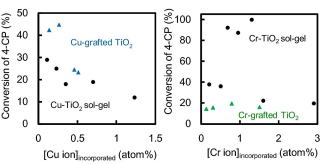 |

| Kinetics of Coloration in Photochromic Tungsten(VI) Oxide/Silicon Oxycarbide/Silica Hybrid Xerogel: Insight into Cation Self-diffusion Mechanisms |
K. Adachi, M. Tokushige, K. Omata, S. Yamazaki, Y. Iwadate
ACS Appl. Mater. Interfaces, 2016, 8, 14019-14028.
DOI : 10.1021/acsami.6b04115
| Abstract: Silicon oxycarbide/silica composites with well-dispersed tungsten(VI) oxide (WO3) nanoparticles were obtained as transparent hybrid xerogels via an acid-catalyzed
sol–gel process (hydrolysis/condensation polymerization) of 3-(triethoxysilyl)propyl
methacrylate (TESPMA) and tetraethoxysilane (TEOS). The self-diffusion
mechanism of alkali-metal cations and the kinetics of the photochromic
coloration process in the WO3/TESPMA/TEOS hybrid xerogel systems have been systematically investigated.
Under continuous UV illumination, a gradual color change (colorless → blue)
corresponding to the reduction of W6+ into W5+ states in WO3 nanoparticles can be confirmed from the WO3/TESPMA/TEOS hybrid xerogels containing alkali-metal sulfates, although
no coloration of the hybrid xerogel without alkali-metal sulfate was observed.
The coloration behavior depended exclusively on a variety of alkali-metal
cations present in the hybrid xerogel system. Furthermore, a detailed analysis
of the self-diffusion mechanism confirmed that the alkali-metal cations
electrostatically interact with a layer of unreacted silanol groups on
the TESPMA/TEOS matrix surface, and subsequently pass through the interconnected
pore network of the hybrid xerogel. More interestingly, in the context
of an Arrhenius analysis, we found a good coincidence between the activation
energies for alkali-metal cation self-diffusion and UV-induced coloration
in the WO3/TESPMA/TEOS hybrid xerogel system containing the corresponding alkali-metal
sulfate. It is experimentally obvious that the photochromic properties
are dominated by the diffusion process of alkali-metal cations in the WO3/TESPMA/TEOS hybrid xerogel system. Such hybrid materials with cation-controlled photochromic properties will show promising prospects in applications demanding energy-efficient "smart windows" and "smart glasses". |
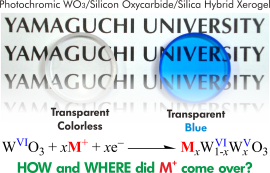 |

| Factors Affecting Oxygen Evolution through Water Oxidation on Polycrystalline
Titanium Dioxide |
Y. Nishimoto, Y. Hasegawa, K. Adachi, S. Yamazaki
RSC Adv., 2016, 6, 46994-47000.
DOI : 10.1039/c6ra06151f
| Abstract: The effect of physicochemical properties such as specific surface area,
crystalline phase, crystallite size, and crystallinity of TiO2 on photocatalytic water oxidation was investigated. Two types of polycrystalline
TiO2 samples which have different physicochemical properties were prepared
by a sol–gel method. The photocatalytic activities of the TiO2 samples for water oxidation were evaluated by the O2 evolution rate from an aqueous silver nitrate solution under ultraviolet
light irradiation. Comparison of the two types of TiO2 samples revealed that the specific surface area and crystalline phase
were not related to the O2 evolution rate. In contrast, a linear relationship between the crystallite
sizes and the O2 evolution rates was observed for most of the TiO2 samples. Crystal face selective Pt and PbO2 depositions on the TiO2 samples were observed by photocatalytic reduction of PtCl62− and oxidation of Pb2+ ions, respectively, indicating that the oxidation and reduction sites
are separated on the surface. An increase in the crystallite size of the
TiO2 promotes a spatial separation of the redox sites and suppresses the electron–hole recombination, leading to the enhancement of the photocatalytic activity. |
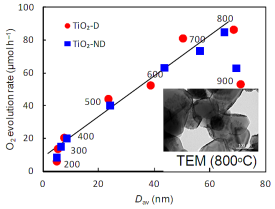 |

<2015> 
| Photochromic Properties of Tungsten Oxide/Methylcellulose Composite Film
Containing Dispersing Agents |
S. Yamazaki, H. Ishida, D. Shimizu, K. Adachi
ACS Appl. Mater. Interfaces, 2015, 7, 26326–26332.
DOI : 10.1021/acsami.5b09310
| Abstract: Tungsten oxide-based photochromic films which changed reversibly in air
between colorless– transparent in the dark and dark blue under UV irradiation
were prepared by using methylcellulose as a film matrix and polyols such
as ethylene glycol (EG), propylene glycol (PG), and glycerin (Gly) as dispersing
agents. Influence of the dispersing agents and water in the films on the
photochromic behavior was systematically studied. Under UV irradiation,
absorption bands around 640 and 980 nm increased and the coloring rate
was the following order: Gly > EG > PG. An increase in the amounts
of dispersing agents or water accelerated the coloring rate. By increasing
the water content of the film, a new absorption peak appeared at ca. 775
nm and the Raman spectra indicated a shift of W–O–W stretching vibration
to lower wavenumber which was due to the formation of hydrogen bonding.
All absorption spectra were fit by three Lorentz functions, whose bands
were ascribed to various packing of WO6 octahedra. After the light was turned off, the formation of W5+ was stopped and bleaching occurred by the reaction with O2 in air to recover its original transparent state. We anticipate that the
biodegradable photochromic films developed in this study can be applied
in recyclable display medium and especially in detachable films for glass
windows whose light transmission properties are changed by sunlight, i.e.,
for usage as an alternative of smart windows without applying voltage. |
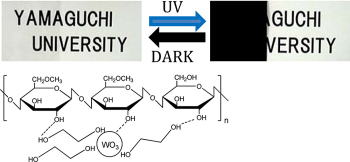 |

| Dioxomolybdenum(VI) and Dioxotungsten(VI) Complexes: Efficient Catalytic
Activity for Crosslinking Reaction in Ethylene-Vinyl Acetate Copolymer
/ Alkoxysilane Composites |
K. Adachi, S. Toyomura, Y. Miyakuni, S. Yamazaki, K. Honda, T. Hirano
Polym. Adv. Technol., 2015, 26, 597-605.
DOI : 10.1002/pat.3491
| Abstract: The catalytic performances of several bis(acetylacetonato)metal complexes
[Cu(acac)2, Zn(acac)2, TiO(acac)2, VO(acac)2, MoO2(acac)2, and WO2(acac)2] were investigated for the crosslinking reaction via transesterifications
in the ethylene-vinyl acetate copolymer/tetraethoxysilane (EVA/TEOS) composite
system by means of dynamic attenuated total reflectance Fourier transform
infrared, solvent swelling, and solid-state 29Si cross polarization/magic angle spinning nuclear magnetic resonance techniques.
Results of the kinetic examination revealed that MoO2(acac)2 and WO2(acac)2 exhibited a higher catalytic activity than di-n-butyltin(IV) oxide, which is a catalyst most commonly used for the transesterification process in polymer system, but has a toxic effect on the environmental health. And furthermore, the crosslink density and final siloxane network structure of crosslinked EVA/TEOS composites are found to be greatly correlated with the catalyst used. On the basis of the SN2-Si pathway, a plausible catalytic mechanism of MoO2(acac)2 and WO2(acac)2 was proposed for the crosslinking reaction via transesterifications of
the vinyl acetate moieties in EVA backbone with the ethoxysilane groups
in one TEOS molecule. The findings in this study may fill the blank in
the high performance and environmentally friendly catalyst in the field
of the crosslinking reactions in polymer system and provide useful clue
for other transesterifications. |
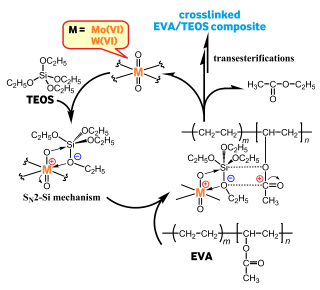 |

| Preparation of Porous Metal-Ion-Doped Titanium Dioxide and the Photocatalytic
Degradation of 4-Chlorophenol under Visible Light Irradiation |
N. Nishiyama, Y. Fujiwara, K. Adachi, K. Inumaru, S. Yamazaki
Appl. Catal. B-Environ., 2015, 176-177, 347-353.
DOI : 10.1016/j.apcatb.2015.04.015
| Abstract: Aiming at developing a highly active photocatalyst to decompose organic
compounds under visible light irradiation, we have prepared metal ion doped
TiO2 (M-TiO2) by conducting dialysis in sol-gel method. Dialysis lead to the formation of mesoporous materials with surface area larger than 200 m2 g-1 but the metal ions should be added into the TiO2 sol at pH 3 in order to avoid their losses during dialysis. Among seven
metal ions tested as dopants, Pt-TiO2 and Cr-TiO2 showed higher photocatalytic activity for the degradation of 4-chlorophenol
under visible light irradiation. The photocatalytic activity of Cr-TiO2 was strongly affected by the doping amount of Cr ion and the optimal value
was evaluated to be 0.68 - 1.30 atom%. X-ray photoelectron spectroscopy
analyses showed the Cr ion was present mainly in Cr(III). The Cr-TiO2 can be used safely for a practical application to remediate environmental contamination instead of expensive Pt-TiO2. |

<2014>
| pH-Responsive Switchable Aggregation Phenomena of Xanthene Dyes Adsorbed
on Tungsten(VI) Oxide Colloid Surface |
K. Adachi, K. Watanabe, S. Yamazaki
Ind. Eng. Chem. Res., 2014, 53, 13046-13057.
DOI : 10.1021/ie5018817
| Abstract: The surface interactions between xanthene (XN) dyes, including rhodamine
B, rhodamine 3B, rhodamine 19, rhodamine 6G, rhodamine 110, and rhodamine
123, and tungsten(VI) oxide (WO3) colloid particles were investigated. These XN dyes were strongly adsorbed
as monolayer onto the WO3 surface via the electrostatic interaction between their peripheral cationic
amino-substituents and negatively surface-charged WO3 colloid particles, and most of ones adsorbed eventually formed the stable
π-stacked dimers. The geometry of dimers formed on the WO3 colloid surface is discussed on the molecular exciton theory framework. Cationic XN dyes formed the approximately ideal face-to-face H-dimers on the WO3 colloid surface, whereas zwitterionic ones had a higher tendency to form
the oblique J-dimers. Additionally, we have experimentally demonstrated the possibility
of pH-induced switching between H- and J-aggregation modes of the XN dye's dimers formed on the WO3 colloid surface. The findings lead to a better understanding of organic
dye's adsorption/aggregation behaviors on the metal oxide surface. |
 |

<2013> 
| Mechanism of Peripheral Substituent Effects on Adsorption-Aggregation Behaviors
of Cationic Porphyrin Dyes on Tungsten(VI) Oxide Nanocolloid Particles |
N. Kanetada, C. Matsumura, S. Yamazaki, K. Adachi
ACS Appl. Mater. Interfaces, 2013, 5, 12991–12999.
DOI : 10.1021/am403751t
| Abstract: The adsorption and aggregation behaviors of the cationic porphyrin derivatives such as 5,10,15,20-tetrakis(4-pyridyl)porphyrin [TPyP], 5,10,15,20-tetrakis(N-methyl-4-pyridyl)porphyrin [TMPyP], 5,10,15,20-tetrakis(N-ethyl-4-pyridyl)porphyrin [TEPyP], and 5,10,15,20-tetrakis(N-n-propyl-4-pyridyl)porphyrin [TPPyP] (hereafter called "TPyP derivatives")
in the tungsten(VI) oxide (WO3) colloid aqueous solution at weak acidic pH were studied by UV–vis spectroscopy. The TPyP derivatives were strongly adsorbed as monolayer onto the WO3 surface via the electrostatic interaction between their peripheral cationic substituents
and negatively surface-charged WO3 colloid particles, and most of the ones adsorbed eventually formed J-type dimers aligned in the head-to-tail fashion. These different dimerization
states were effectively analyzed by the change of ratios among the intensities
of exciton split Soret bands (H- and J-bands). Judging from the exciton coupling theory and adsorption measurements,
we concluded that the J-dimer geometry of the TPyP derivatives adsorbed on the WO3 colloid particle surface is strongly dependent on the presence and difference
of peripheral substituents. The results described here indicate a new and
promising way of designing surface supramolecular structures combination
of two principles, the self-association of organic dyes, and the steric
repulsive interaction between the peripheral substituents and the inorganic
semiconductor surfaces. |
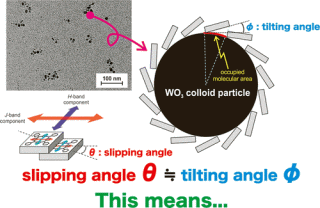 |

| Surface-Enhanced Photochromic Phenomena by Phenylalanine Adsorbed on Tungsten Oxide Nanoparticles: A Novel Approach for "Label-Free" Colorimetric Sensing |
S. Tanaka, K. Adachi, S. Yamazaki
Analyst, 2013, 138, 2536-2539. (selected "Back Cover")
DOI : 10.1039/c3an36650b
| Abstract: The enhanced photochromic behaviors of the L-phenylalanine (Phe)/tungsten(VI)
oxide (WO3) colloid binary aqueous solution have been investigated by means
of UV-vis absorption spectrometry. The phenomena provided a potential use
of the WO3 nanoparticles as a colorimetric probe for sensitive “label-free”
detection of amino acid compounds. |
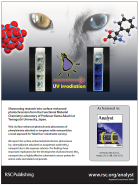 |
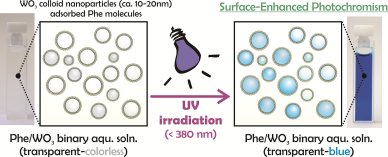 |

| Photocatalytic Activity of Aqueous WO3 Sol for the Degradation of Orange II and 4-Chlorophenol |
S. Yamazaki, T. Yamate, K. Adachi
Appl. Catal. A-Gen., 2013, 454, 30-36.
DOI : 10.1016/j.apcata.2012.12.038
| Abstract: Photocatalysis of a transparent aqueous WO3 sol was investigated for the color-fading of Orange II. Dependence of the degradation rate of Orange II on pH and ionic strength of the WO3 sol was explained in terms of the electrostatic interaction between Orange II and the WO3 colloid particles. The degradation rate follows the first-order kinetics
with respect to the concentration of Orange II. It was demonstrated that
the photogenerated electron in WO3 reduced O2 effectively since the photochromism of the WO3 sol observed under nitrogen atmosphere did not occur under air-saturated condition. The photocatalytic activity of WO3 was lower than that of TiO2 by a factor of 0.5 and was enhanced by mixing with the TiO2 sol. The best photocatalytic performance for the degradation of Orange
II was obtained by using the mixed sol with WO3:TiO2 molar ratio of 1:2. Similar enhancement in the photocatalytic activity
was confirmed for the degradation of 4-chlorophenol. |
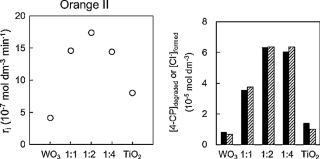 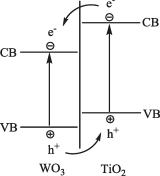 |

<2012> 
| Kinetics of Photocatalytic Degradation of Trichloroethylene in Aqueous
Colloidal Solutions of TiO2 and WO3 nanoparticles |
T. Seyama, K. Adachi, S. Yamazaki
J. Photochem. Photobiol. A Chem, 2012, 249, 15-20.
DOI : 10.1016/j.jphotochem.2012.09.001
| Abstract: Kinetic studies on the photocatalytic degradation of trichloroethylene
(TCE) were performed in TiO2 or WO3 aqueous sol which consisted of anatase nanocrystalline TiO2 of ca. 3.9 nm or WO3 spherical particles of ca. 17.6 nm, respectively. Photocatalytic activity
of TiO2 colloid is higher than that of WO3 by a factor of 2.1. Kinetic analyses for both sols give a similar rate
law containing γ value which represents a ratio of the reaction rate of
the photogenerated electrons with O2 against the total disappearance rate of the photogenerated electrons.
Reaction temperature did not affect the TiO2 photocatalysis whereas higher temperature increased the oxidation rate
of TCE in the WO3 sol. Such a difference in the temperature effect was explained in terms
of the γ values. The photocatalytic degradation of TCE was enhanced by
mixing the WO3 and the TiO2 sol and the best performance was obtained by using the mixed sol with
WO3:TiO2 molar ratio of 1:2. In the mixed sol, the similar temperature dependence as in the WO3 sol was obtained. Reaction mechanism and the rate law are proposed to
account for the obtained kinetic data. |
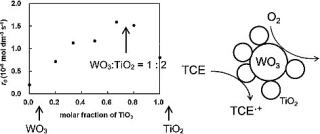 |

| Chirality Induction and Amplification in Methylene Blue H-Aggregates via D- and L-Phenylalanine Pre-Adsorbed on the Tungsten Oxide Nanocolloid
Surface |
K. Adachi, S. Tanaka, S. Yamazaki, H. Takechi, S. Tsukahara, H. Watarai
New J. Chem., 2012, 36, 2167-2170 (selected "Inside Front Cover")
DOI : 10.1039/c2nj40415j
| Abstract: In the methylene blue (MB)/phenylalanine (Phe)/tungsten(VI) oxide (WO3) colloid ternary aqueous solution, the MB H-aggregates, which could recognize
the chirality of D- and L-Phe, were formed and investigated by means of
UV-Vis absorption and CD spectroscopy. These results demonstrate a chirality
transfer and amplification from only the pre-adsorbed Phe molecules to
MB aggregates formed on the WO3 colloid surface via non-covalent interactions. |
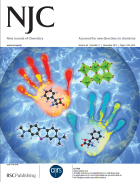 |
 |

| Synthesis of Porous Platinum-Ion-Doped Titanium Dioxide and the Photocatalytic
Degradation of 4-Chlorophenol under Visible Light Irradiation |
S. Yamazaki, Y. Fujiwara, S. Yabuno, K. Adachi, K. Honda
Appl. Catal. B-Environ., 2012, 121-122, 148-153
DOI : 10.1016/j.apcatb.2012.03.026
| Abstract: Porous platinum-ion-doped TiO2 (Pt-TiO2) with BET surface area higher than 200 m2 g-1 was prepared by using water as solvent and conducting dialysis in a sol-gel method and demonstrated to have superior photocatalytic activity for the photodegradation of 4-chlorophenol (4-CP) under both ultraviolet and visible light (VL) irradiation. During dialysis, 76.5% of Cl was removed and mesopores were formed in Pt-TiO2. Measurements of pore-size distribution indicated a peak at ca. 3 nm after the calcination of Pt-TiO2 at 200C. Optimal conditions to prepare Pt-TiO2 acting under VL were 0.5 at.% as the Pt-doping content and 200C as the
calcination temperature in the range of 200-500C. Kinetic studies were
performed to clarify the effect of the amount of Pt-TiO2, initial concentration of 4-CP, intensity and wavelength of the incident
light, pH and temperature on the reaction rate and to obtain the rate law
under VL irradiation. Formation of benzoquinone and hydroquinone as intermediates
was observed. They were further photodegraded on Pt-TiO2 and 90.7% of 4-CP was completely mineralized at the VL irradiation of
390 min. |
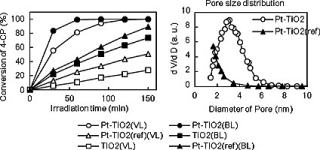 |

| Kinetic Characteristics of Enhanced Photochromism in Tungsten Oxide Nanocolloid Adsorbed on Cellulose Substrates, Studied by Total Internal Reflection Raman Spectroscopy |
K. Adachi, T. Mita, S. Tanaka, K. Honda, S. Yamazaki, M. Nakayama, T. Goto, H. Watarai
RSC Adv., 2012, 2, 2128-2136
DOI : 10.1039/c2ra00217e
| Abstract: The nanostructured tungsten(VI) oxide (WO3)/cellulose derivatives (cellulose (CE) and triacetyl cellulose (TACE))
hybrid films were prepared by a solution-dipping adsorption process, and
their structure and optical properties have been investigated. Various
techniques, including adsorption isotherm, transmission electron microscopy
(TEM), X-ray diffraction (XRD), atomic force microscopy (AFM), energy-dispersive
X-ray spectroscopy (EDX), in situ UV-Vis absorption, and in situ total internal reflection Raman spectroscopy, were used for the characterization
of the WO3/CE and WO3/TACE hybrid materials. Under UV irradiation, the photochromism (colorless
→ blue) was confirmed from the WO3/CE hybrid film, although no coloration of the WO3/TACE hybrid film was observed. This distinct difference in the coloration
suggested that the interfacial interaction between hydroxyl groups present
on the surface of the CE substrate and WO3 nanoparticles via hydrogen bonding plays a major role in the enhancement of photochromism in the WO3/CE hybrid system. Moreover, the joint evidence in in situ UV-Vis absorption and in situ total internal reflection Raman studies clearly revealed that the photogenerated
coloration is related to a partial reduction of W6+ cations into W5+ cations in the WO3/CE hybrid film. The findings in this study have great implications for the development of the novel green-functional inorganic/organic hybrid materials in optical devices. |
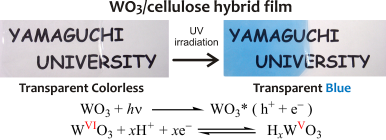
|

<2011> 
| Kinetic Study on Photochromism of WO3 Aqueous Sol and its Enhancement Accompanying Spectral Changes by the Addition
of TiO2 Aqueous Sol |
S. Yamazaki, T. Yamate, K. Adachi
Colloids and Surfaces A: Physicochem. Eng. Aspects., 2011, 392, 163-170
DOI : 10.1016/j.colsurfa.2011.09.050
| Abstract: Photochromism of a WO3 aqueous sol has been investigated in a nitrogen atmosphere under controlled temperature. Effects of ageing of the WO3 sols, concentrations of WO3 sols or Cl− ion and temperature on the coloring rate were examined. The coloring rate
was the first-order with respect of the WO3 concentration. The coloring process was accelerated by an addition of
TiO2 aqueous sols. Spectral changes were measured using the mixing sol with various molar ratios (γ) of WO3 and TiO2. The absorption spectra changed from those having the single peak at 775
nm to those with two peaks at 640 and 980 nm. Such spectral transformation
was ascribed to the structural change of the WO3 nanoclusters, depending
on the γ value and the concentration of Cl− ion. |
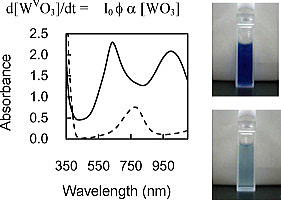 |

| In situ Binary Sol-Gel Reaction of Various Trifunctional Alkoxysilane in the Silane-Grafted
Polyolefin Matrix and its Effect upon the Mechanical Properties |
K. Adachi, K. Honda, S. Yamazaki, T. Hirano, H. Kurokawa, A. Wakabayashi, P.H. Kasai, K. Nakamae, H. Iwabuki,
K. Murakami
Polym. Eng. Sci., 2011, 51, 632-640
DOI : 10.1002/pen.21856
| Abstract: The vinyltrimethoxysilane-grafted ethylene-propylene copolymer/trifunctional
methoxysilane (EPR-g-VTMS/RTMS) composites were prepared via in situ silica sol-gel reactions. Five trifunctional methoxysilane compounds (n-hexyltrimethoxysilane, n-decyltrimethoxysilane, n-tetradecyltrimethoxysilane, n-octadecyltrimethoxysilane, and phenyltrimethoxysilane) have been selected
for this study. The water-cross-linked EPR-g-VTMS/RTMS composites were
characterized by attenuated total reflectance-Fourier transform infrared
spectroscopy, gel content, solid-state 29Si CP/MAS NMR, wide-angle x-ray scattering, tensile strength, and field emission scanning electron microscopy measurements. The type of RTMS additive has a substantial influence on the nature of siloxane band networks and eventually the mechanical tensile properties. This finding suggests that the interaction and/or entanglement between the EPR-g-VTMS matrix and the substituent of the RTMS additives are crucial for the modifying mechanical properties. Moreover, for the water-cross-linked EPR-g-VTMS/CnTMS (n = 6, 10, 14, and 18) composites, the joint evidence provided by attenuated
total reflectance-Fourier transform infrared spectroscopy, 29Si CP/MAS NMR, and wide-angle x-ray scattering results suggested the formation
of ladder-type poly(n-alkyl silsesquioxane)s and the presence of the highly ordered structure
with a thickness equal to the length of two n-alkyl groups in all-trans conformation. |
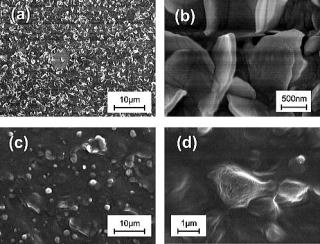 |

<2010> 
| Photocatalytic Degradation of Chlorinated Ethanes in the Gas Phase on the Porous TiO2 Pellets - Effect of Surface Acidity |
S. Yamazaki, K. Ichikawa, A. Saeki, T. Tanimura, K. Adachi
J. Phys. Chem. A, 2010, 114, 5092-5098
DOI : 10.1021/jp911842t
| Abstract: The photocatalytic degradation of chlorinated ethanes was studied in a
tubular photoreactor packed with TiO2 pellets prepared by sol-gel method. The steady-state condition was not
obtained, but the deterioration in the photocatalytic activity was observed
during the irradiation. Effects of mole fractions of water vapor, O2, and C2H5Cl or C2H4Cl2 and reaction temperature on the photodegradation of C2H5Cl or C2H4Cl2 were examined, and these data were compared with those obtained by the photodegradation of chlorinated ethylenes. On the basis of the products detected with and without oxygen in the reactant's gas stream, we proposed the degradation mechanism. Measurement of diffuse reflectance infrared Fourier transform spectroscopy of pyridine adsorbed on the catalysts showed that decrease in the conversion for the photodegradation of C2H5Cl was attributable to the formation of Brønsted acid sites. Comparison
of the data obtained with the TiO2 and the sulfated TiO2 (SO42-/TiO2) pellets indicated that the photodegradation of C2H5Cl was suppressed by the presence of the Brønsted sites, but that of trichloroethylene was not affected. Such a difference is attributable to the adsorption process of these reactants on the acid sites on the catalyst surface. |
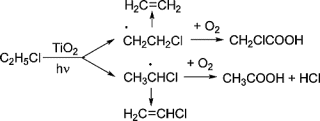 |

| Controllable Adsorption and Ideal H-Aggregation Behaviors of Phenothiazine Dyes on the Tungsten Oxide Nanocolloid Surface |
K. Adachi, T. Mita, T. Yamate, S. Yamazaki, H. Takechi, H. Watarai
Langmuir, 2010, 26, 117-125
DOI : 10.1021/la902174s
| Abstract: The monomer−aggregate equilibrium of four phenothiazine (PN) dyes, containing
thionine (TH), methylene blue (MB), new methylene blue (NMB), and 1,9-dimethylmethylene
blue (DMB), in the tungsten(VI) oxide (WO3) nanocolloid solution has been investigated by means of UV−vis spectroscopy. Addition of PN dye into the WO3 nanocolloid solution brought about significant changes in the absorption spectrum, suggesting the formation of H-type (face-to-face fashion) trimer on the WO3 nanocolloid surface. The adsorptivity of PN dyes onto the WO3 nanocolloid surface was diminished by the raising the ionic strength,
indicating the evidence of the electrostatic interaction between cationic
PN dye and negatively charged WO3 nanocolloids. The detail analysis of each spectral data provided insight
into the effect of molecular structure of PN dyes on the adsorption and
aggregation behaviors on the WO3 nanocolloid surface. Moreover, in situ measurement of PN dye aggregation
using the centrifugal liquid membrane (CLM) technique revealed that the
aggregation of PN dyes on the WO3 nanocolloid surface proceeded in a two-step three-stage (monomer → dimer → trimer) formation. The aggregation mechanism of PN dyes on the WO3 nanocolloid surface was discussed on the basis of Kasha’s exciton theory. |
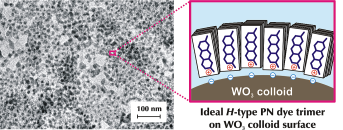 |

| Preparation and Photocatalytic Activity of Cu-Deposited TiO2 Film with High Transparency |
S. Yamazaki, M. Sugihara, E. Yasunaga, T. Shimooka, K. Adachi
J. Photochem. Photobiol, A: Chem., 2010, 209, 74-78
DOI : 10.1016/j.jphotochem.2009.11.002
| Abstract: Cu-deposited TiO2 films were prepared by photoreduction of Cu(II) in the presence of sodium
formate. With the initial Cu(II) concentrations more than 100 mg L-1, induction periods were observed before the transmittance decreased. Scanning electron microscopy indicated that Cu particles of 2.6 ± 0.5 μm were deposited isolatedly with much open space in the induction periods. The films prepared by changing the irradiation time within the induction periods showed a higher photocatalytic activity than a pure TiO2 for the degradation of methylene blue under the reaction condition without
purging air. |
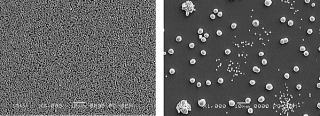 |

| Ethylene-Propylene Copolymer/Ordered Poly(silsesquioxane) Nanocomposites
Prepared via Organic Acid- or Base-Catalyzed Binary Silica Water-Crosslinking Reactions |
K. Adachi, T. Hirano, P.H. Kasai, K. Nakamae, H. Iwabuki, K. Murakami
Polym. Int., 2010, 59, 510-516
DOI : 10.1002/pi.2729
| Abstract: In situ silica sol–gel-derived organic–inorganic hybrid materials, which comprise a vinyltrimethoxysilane-grafted ethylene–propylene copolymer (EPR-g-VTMS) and n-hexyltrimethoxysilane (HTMS), were successfully prepared in the presence of an organic acid and base catalyst. Benzenesulfonic acid and aniline were selected as the organic acid and base catalyst, respectively, to examine the progress and effect of progressive changes in the silane water-crosslinking reaction of EPR-g-VTMS/HTMS composites. The water-crosslinked EPR-g-VTMS/HTMS composites were characterized by means of attenuated total reflectance Fourier transform infrared spectroscopy, gel content, solid-state 29Si cross-polarization/magic-angle spinning NMR, wide-angle X-ray scattering,
tensile strength and field-emission scanning electron microscopy measurements.
These results revealed that the type of catalyst has a substantial influence
on the nature of siloxane bonds and eventually the physical tensile properties
of the water-crosslinked EPR-g-VTMS/HTMS composites, which can be explained
mainly from knowledge of the traditional acid- and base-catalyzed silica
sol–gel reaction. Moreover, an in-depth analysis of the aniline-catalyzed
composites indicated the formation of ladder-type poly(n-hexylsilsesquioxane)s and the presence of a highly ordered structure with
a thickness equal to the length of two n-hexyl groups in all-trans conformation. We demonstrate potential for the
future design of highly ordered silicate-based organic–inorganic hybrid
nanocomposites. |
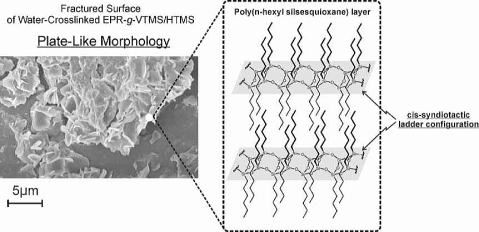 |

| 金属酸化物半導体ゾルを反応場とした超分子色素集合体制御と有機・無機ハイブリッド太陽電池材料への応用 |
安達健太
財団法人 近畿地方発明センター 研究助成成果報告書, 2010, 47-53.

<2009> 
| Structural Effects of Titanium(IV) Oxide Encapsulated in a Hollow Silica Shell on Photocatalytic Activity for Gas-phase Decomposition of Organics |
S. Ikeda, H. Kobayashi, Y. Ikoma, T. Harada, S. Yamazaki, M. Matsumura
Appl. Catal. A: Gen., 2009, 369, 113-118
DOI : 10.1016/j.apcata.2009.09.008
| Abstract: TiO2 particles encapsulated in hollow silica shells with controlled shell thicknesses
were fabricated. Compared to naked TiO2 without coverage by a hollow silica shell, all of these composites showed
low levels of photocatalytic activity for gas-phase decomposition of acetone
into CO2. The activities over these composites tended to decrease with increase in thickness of the lateral silica shell. These results can be explained by a decrease in the diffusion of acetone with increase in thickness of the silica shell, leading to hampering of supply of the substrate to the surfaces of core TiO2 particles. In contrast, for the overall photodecomposition of gaseous
2-propanol into CO2, the presence of the lateral silica shell was found to be beneficial,
i.e., the composite induced a high level of activity compared to the activity
of naked TiO2. The enhancement of activity for this reaction was likely to be due to
condensation of the intermediate product of acetone in the void spaces,
leading to an increase in the collision probability between acetone and
the surface of the TiO2 core. |
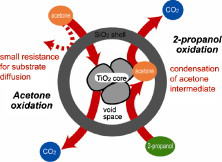 |

| Effect of Thermal Treatment on Photocatalytic Degradation of Ethylene,
Trichloroethylene and Chloroform |
S. Yamazaki, H. Abe, T. Tanimura, Y. Yamasaki, K. Kanaori, K. Tajima
Res. Chem. Intermed., 2009, 35, 91-101
DOI : 10.1007/s11164-008-0001-9
| Abstract: The thermal treatment of TiO2 pellets prepared by the sol–gel method decreased the photocatalytic activity. The activity divided by the specific surface area of the pellets for the complete mineralization of ethylene or chloroform was maximized at the firing temperature of 400°C. For the photocatalytic degradation of trichloroethylene (TCE), most of them were converted to chlorinated by-products, such as dichloroacetic acid, chloroform, and phosgene, and the stoichiometric ratio of [CO2]formed/[TCE]degraded showed a maximal value at 400°C. The electron spin resonance (ESR) spin-trapping with 5,5-dimethyl-1-pyrroline-N-oxide (DMPO) in the flow injection system indicated that firing at 400°C gave the highest signal intensity of DMPO–OH adducts. These findings indicated that the OH radical was produced most effectively on the TiO2 fired at 400°C, which would be related to the content of anatase and rutile. Concerning the formation of chlorinated by-products from TCE, more dichloroacetic acid (DCAA) were detected and less CHCl3 and COCl2 were formed at lower firing temperatures, suggesting that the branching
ratio of chloroethoxy radicals to the formation of DCAA or CHCl3 and COCl2 by C–C bond scission depended on the firing temperature. |
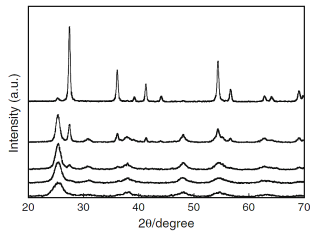 |

| Enhanced of Photodegradation of Organic Dyes Adsorbed on a Clay |
S. Tani, H. Yamaki, A. Sumiyoshi, Y. Suzuki, S. Hasegawa, S. Yamazaki, J. Kawamata
J. Nanosci. Nanotechnol., 2009, 9, 658-661
DOI : 10.1166/jnn.2009.J081
| Abstract: The interaction of three photoactive organic dyes, Rhodamine B, Rhodamine
6G and a stilbazolium derivative 4’-dimethylamino-N-methyl-4-stilbazolium
with synthetic sodium-saponite has been examined by UV-visible absorption
spectroscopy. In all cases, bathochromic shifts and the reduction of peak
absorbance for the dyes were observed in the absorption spectra at a low
dye concentration (25% adsorption of the cation exchange capacity (CEC)
of the clay), although the shape and the width of their absorption bands
were similar to those in aqueous solution. This absorption behavior indicates
that the organic dye molecules adsorbed onto the surface of the negatively
charged clay particles and the adsorbed molecules were well dispersed.
The photodegradation of the organic dyes in aqueous solution and in the
clay suspension has been also examined by the irradiation of a laser beam
at a wavelength of 532 nm. We have found that the hybridization of the
organic dyes with the exfoliated clay particles largely enhanced a photodegradation.
The clay particles acted as a catalyst even at a high concentration such
as ∼300% of CEC. |
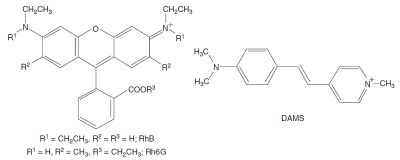 |

| The Utility of Sulfonic Acid Catalysts for Silane Water-Crosslinked Network Formation in the Ethylene-Propylene Copolymer System |
K. Adachi, T. Hirano
J. Sol-Gel Sci. Tech., 2009, 49, 186-195
DOI : 10.1007/s10971-008-1857-2
| Abstract: Catalytic effects of Bronsted acid on the early kinetics of water-crosslinking
reaction in the vinyltrimethoxysilane-grafted ethylene–propylene copolymer
(EPR-g-VTMS) system were investigated by means of an attenuated total reflectance-Fourier
transform infrared (ATR-FTIR) technique and gel fraction measurements.
Four sulfonic acids with different substituent, including methanesulfonic
acid (C1SO3H), 1-propanesulfonic acid (C3SO3H), 1-pentanesulfonic acid (C5SO3H), and dodecylbenzenesulfonic acid (C12PhSO3H), were selected to examine the progress and effect of progressive changes in the silane water-crosslinked network structure in comparison with a primary amine (n-octadecylamine, Lewis base). From the kinetic analysis using Arrhenius equation, we found that the frequency factors for both hydrolysis (ATR-FTIR) and condensation step (gel content) of EPR-g-VTMS decreased in the order of C1SO3H > C3SO3H > C5SO3H > C12PhSO3H, while the activation energy values for each reaction did not differ
significantly. These relationships can be explained mainly on the basis
of the diffusion factors of the sulfonic acids in EPR-g-VTMS system. Moreover,
the stress–strain curve comparison between water-crosslinked EPR-g-VTMS
samples containing sulfonic acid and amine compound clearly indicated the
difference in their tensile properties as a result of the catalyst variation;
the use of sulfonic acid as water-crosslinking catalyst eventually achieves
to the soft and tough water-crosslinked EPR-g-VTMS, while the hard and
strong one was produced using amine catalyst. Not only the catalytic activity
but also the type of the catalyst has eventually significant effects upon
the physical properties of the water-crosslinked EPR-g-VTMS. |
 |

| 酸化タングステンと酸化チタン複合体によるフォトクロミズム材料の開発 |
山崎鈴子
財団法人 池谷科学技術振興財団 年報, 2009, 20, 166.

<2008> 
| Photocatalytic Degradation of 4-tert-Octhlphenol in Water and the Effect
of Peroxydisufate as Additives |
S. Yamazaki, T. Mori, T. Katou, A. Saeki, M. Sugihara, T. Tanimura
J. Photochem. Photobiol.A: Chem., 2008, 199, 330-335
DOI : 10.1016/j.jphotochem.2008.06.017
| Abstract: Photocatalytic degradation of 4-(tert-octyl)phenol (4-OP) has been investigated
by recirculating the aqueous solution through a packed bed reactor with
TiO2. The first-order rate constant k for the degradation of 4-OP was evaluated
to be 5.40×10−3 min−1 and an activation energy of 18.6 kJ mol−1 was obtained. The rate constant k was not dependent of the flowrate but a decrease in total organic carbon (TOC) became smaller as the flowrate increased. Under the illumination for 6 hrs at the flowrate of 28.5 ml min−1, 83.2% of 4-OP was degraded but 60.7% of the initial TOC was remained.
Measurements of LC/MS using electrospray ionization revealed the formation
of byproducts having molecular weights of 136, 178, 192, 220 and 222. Possible
candidates for these byproducts were proposed. The degradation rate of
4-OP was remarkably accelerated by addition of K2S2O8: 4-OP was completely disappeared under irradiation of 4 or 2 hrs, respectively,
in the presence of 4×10−3 or 2×10−2 mol dm−3 K2S2O8. In the latter case, the TOC decreased to 34.6% by continuing the irradiation
even after 4-OP was disappeared. In the presence of S2O82−, 4-OP was degraded without TiO2, which is attributable to the reaction by SO4− radicals. We demonstrated that the UV/TiO2/S2O82− system was more appropriate than the UV/S2O82− for decontamination of 4-OP in water. |
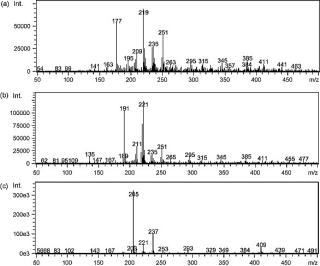 |

| Photocatalytic Reactivity of Transparent Titania Sols Prepared by Peptization of Titanium Tetraisopropoxide |
S.Yamazaki, N. Nakamura
J. Photochem. Photobiol. A:Chem., 2008, 193, 65-71
DOI : 10.1016/j.jphotochem.2007.06.008
| Abstract: Photocatalysis of a transparent aqueous sol, which was prepared by peptizing
titanium tetraisopropoxide in nitric acid for 7 days followed by dialysis
was examined for the color-fading of methylene blue (MB) and Orange II
and for the degradation of 4-chlorophenol (4-CP). Measurements of XRD patterns
of the powders obtained by drying the sol indicated the formation of anatase.
Under argon-bubbling, MB was degraded via the formation of colorless leuco
form and the color of the sol returned to original by bubbling air in the
dark. Reaction rates for oxidative degradation of MB under air-bubbling
showed maximum at the 0.013 mol-Ti dm−3 in the sol and at pH 4.2. Reaction rates for color-fading of Orange II
were higher by a factor of 6.8 than that of MB. The dependence of rates
on the concentrations of MB or Orange II in the sol was discussed with
the rate law. For the degradation of 4-CP in the sol under the irradiation
for 6 hrs, 92.7% of 4-CP was completely dechlorinated and 69.5% of the
initial TOC was decreased. |
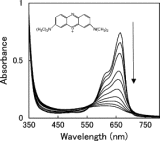 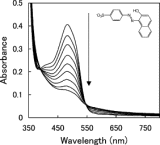 |

| Linear Dichroism of Zn(II)-Tetrapyridylporphine Aggregates Formed at the Toluene/Water Interface |
H. Takechi, K. Adachi, H. Monjushiro, H. Watarai
Langmuir, 2008, 24, 4722-4728
DOI : 10.1021/la7027862
| Abstract: The apparent circular dichroism (CD) and the linear dichroism (LD) spectra
of the aggregates of achiral zinc(II)-5,10,15,20-tetra(4-pyridyl)-21H,23H-porphine
(ZnTPyP), formed at the toluene/water interface in a centrifugal liquid
membrane (CLM) cell, were investigated by comparison with the microscopic
CD and LD spectra of a single interfacial aggregate of ZnTPyP about 100
μm in length, measured by a microscope−spectropolarimeter. The interfacial
ZnTPyP aggregate showed two types of flat trapezoidal shapes, one had a
seedlike core at an edge (type I) and another a needlelike core at an edge
(type II). The microscopic CD and LD spectra were observed by varying the
angle between the parallel axis of the trapezoidal aggregate and the perpendicular
axis of a polarized light for LD. The plot of the CD intensity against
the LD intensity for a single aggregate, observed at a given wavelength,
showed a rotated elliptical shape with a long axis through the origin,
when the orientation angle was changed. From these results, it was concluded
that the apparent CD spectra observed by the CLM-CD method were mainly
due to the large linear dichroism of the aggregate. Both type I and type
II structures showed two transition dipole moments, parallel and perpendicular
to the long axis of the structure, but suggesting a more developed J-aggregate
in type II structure. AFM measurements showed that the interfacial ZnTPyP
aggregate had a multilayer structure, in which the unit monolayer thickness
was 1.58±0.23 nm. Finally, the orientation angle of the interfacial aggregate
in the CLM cell was estimated as 41°−44° to the rotating axis of the cell. |
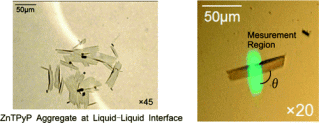 |

| Controllable Silane Water-Crosslinking Kinetics and Curability of Polyolefin Resin by Amine Compounds |
K. Adachi, T. Hirano
Ind. Eng. Chem. Res., 2008, 47, 1812-1819
DOI : 10.1021/ie0708069
| Abstract: Catalytic effects on the water-cross-linking process (hydrolysis and condensation)
of vinyltrimethoxysilane-grafted ethylene−propylene copolymer (EPR-g-VTMS)
were investigated for several amine compounds (primary, secondary, and
tertiary). Silane water-cross-linking kinetics and curability of EPR-g-VTMS
samples containing each specific amine were analyzed by the ATR-FTIR technique
and gel-fraction method using xylene as an eluent. The primary amine showed
the strongest catalytic effect, followed by the secondary one. The tertiary
amine, meanwhile, showed little catalytic effect. Moreover, the amine compound
with a small substituent had a much faster initial rate of the silane water-cross-linking
reaction than the one with a large substituent. In order to gain visual
insights into the hydrolysis and condensation of an alkoxysilane in the
presence of the amine compound, the plausible reaction intermediates were
examined using a semiempirical molecular orbital method (AM1 level) for
each case. The novel possible catalytic mechanism for the amine compounds
in the EPR-g-VTMS system is proposed on the basis of these results and
the knowledge of traditional silicate sol−gel reactions. |
 |

| Good Linear Relationship between Logarithms of Eigen's Water Exchange Constants for Several Divalent Metal Ions and Activation Energies of Corresponding Metal-Catalyzed Alkoxysilane Hydrolysis in Ethylene-Propylene Copolymer System |
K. Adachi, T. Hirano
Eur. Polym. J., 2008, 44, 542-549
DOI : 10.1016/j.eurpolymj.2007.11.033
| Abstract: Catalytic efficiencies of seven divalent metal acetylacetonate complexes
[M(acac)2; M = Cd(II), Co(II), Cu(II), Fe(II), Ni(II), Pb(II), and Zn(II)] with
respect to the water-crosslinking kinetics of vinyltrimethoxysilane-grafted
ethylene-propylene copolymer (EPR-g-VTMS) were investigated to examine
the effects of progressive changes in metal ion using ATR–FTIR spectroscopy.
The hydrolysis activation energies of EPR-g-VTMS follows the order: No
catalyst ≈ Ni(acac)2 > Co(acac)2 > Fe(acac)2 ≈ Zn(acac)2 > Cd(acac)2 ≈ Cu(acac)2 > Pb(acac)2. Interestingly, the kinetics results revealed that the plots of hydrolysis
activation energies of EPR-g-VTMS containing M(acac)2 complexes and Eigen's water exchange constants for corresponding metal
ions showed a excellent linear relationship, suggesting that the reaction
pathway for the silane water-crosslinking with hydrous M(acac)2 complex in EPR-g-VTMS system may be similar to that for water exchange of the metal ion in an aqueous system. Based on the knowledge of traditional kinetics studies by Eigen and Wilkins and hybrid sol–gel chemistry, the plausible catalytic mechanism for M(acac)2 complexes in EPR-g-VTMS system was proposed. |
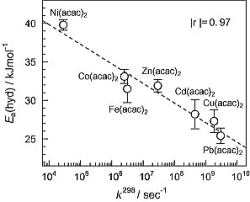 |

| Adsorption and Photocatalytic Degradation of 1,4-Dioxane on TiO2 |
S. Yamazaki, N. Yamabe, N. Nagano, A. Fukuda
J. Photochem. Photobiol. A: Chem., 2007, 185, 150-155
DOI : 10.1016/j.jphotochem.2006.05.024
| Abstract: 1,4-Dioxane in hexane as a solvent was adsorbed on TiO2 due to an electrostatic interaction. The porous TiO2 pellets (SG) prepared by sol–gel method were superior adsorbent to ST-B21
and Degussa P-25. Effects of firing temperature of the pellets and the
initial concentrations of 1,4-dioxane on the adsorption percents were examined.
Photocatalytic degradation of aqueous 1,4-dioxane gave 1,2-ethanediol diformate
and formic acid as intermediates. Analysis of total organic carbon indicated
that 1,4-dioxane was mineralized effectively in the following order: P-25
> ST-B21 > SG. The photocatalytic degradation of 1,4-dioxane adsorbed
on the TiO2 pellets in air showed that ST-B21 had a higher activity than SG. These
facts indicate that SG pellet acts as a good adsorbent because of its high
specific surface area but the internal region of the pores is not illuminated
and acts only as a support. |
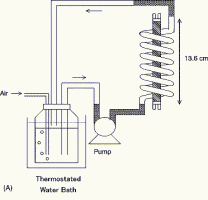 |

| 鉄腐食と導電性高分子ポリアニリンのコーティングによる鉄腐食防止の教育システムの開発とその教育効果 |
矢野潤, 中村紀幸, 山崎鈴子, 一森勇人, 尾崎信一, 岡野 寛
工学教育, 2007, 55, 37-42
DOI : 10.4307/jsee.55.2_37
| Abstract: Few general chemistry textbooks of high schools, colleges and universities
introduce the corrosion of iron into the oxidation-reduction (redox) section,
although the corrosion is very popular phenomena for students. Besides,
no description appears about conductive polymers as anti-corrosion materials.
The corrosion is a redox reaction proceeding through the local cell mechanism
: the iron oxidation half-cell reaction at the local anode and the reduction
of oxygen at the local cathode. To prepare a teaching tool for understanding
of the mechanism, the visualization of the corrosion was attempted using
phenolphthalein and potassium hexacyanoferrate (III) as color couplers
for the anodic and cathodic products : Fe2+ and OH-. The local anode and cathode were obviously shown as gradual blue and red coloration when commercial nails were soaked in 4% NaCl aqueous solution containing phenolphthalein and potassium hexacyanoferrate (III) . On the other hand, no coloration occurred for the nail covered with a conductive polymer polyaniline. To know the anti-corrosion mechanism, the open-circuit potential of the nail was measured. The fact that the potential was kept at the potential range where iron was passivated implied that polyaniline acted as an in-situ oxidant. The visualization was experimentally performed at an actual chemistry class and the utility value was estimated. As a result, the visualization is expected to be a useful teaching tool for the corrosion and the understanding of the role of polyaniline as the anti-corrosion material. |
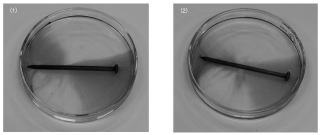 |

| Accelerated Silane Water-Crosslinking Kinetics of Ethylene-Propylene Copolymer by Boron Trifluoride Complexes |
K. Adachi, T. Hirano, K. Fukuda, K. Nakamae
Macromol. React. Eng., 2007, 1, 313-320
DOI : 10.1002/mren.200600044
| Abstract: The hydrolysis and overall water-crosslinking kinetics of vinyltrimethoxysilane-grafted
ethylene–propylene copolymer (EPR-g-VTMS) containing boron trifluoride
monoethylamine complex (BF3–MEA), boron trifluoride methanol complex (BF3–MeOH), or di-n-butyltin(II) dilaurate (DBTL) as a silane-crosslinking catalyst was followed by ATR-FT-IR and measuring the gel fraction, respectively. Kinetics results by ATR-FT-IR technique showed that using BF3–MEA provided much lower activation energy for the hydrolysis reactions
than that of DBTL; however, BF3–MeOH had little catalytic effect on both the hydrolysis and overall water-crosslink
reaction of EPR-g-VTMS. We propose that the actual catalytic effect of
ethylamine molecule dissociated from BF3–MEA results in the displacement of Si-OCH3 groups via an SN2-Si mechanism. |
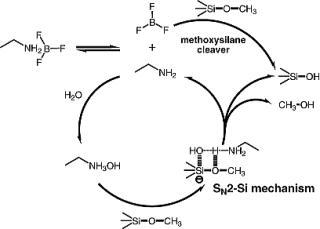 |

<2006> 
| Control of Optically Active Structure of Thioether-Phthalocyanine Aggregates by Chiral Pd(II)-BINAP Complexes in Toluene and at the Toluene/Water Interface |
K. Adachi, K. Chayama, H. Watarai
Chirality, 2006, 18, 599-608.
DOI : 10.1002/chir.20293
| Abstract: The Pd(II)-2,2'-bis(diphenylphosphino)-1,1'-binaphthyl (BINAP)-mediated chiral assembly of thioether-derivatised phthalocyanatomagnesium(II) compounds (MgPc(SR)8, SR is benzylthio (SBz) or benzhydrylthio (Bh)) was formed in toluene
and at the toluene/water interface, and investigated by means of UV-Vis
absorption and circular dichroism (CD) spectroscopy combined with the centrifugal
liquid-membrane (CLM) devise. Interfacial tension measurements indicated
that, in the presence of PdSO4 in the aqueous phase, BINAP ligand adsorbed
as a monolayer forming Pd(II)BINAP2+ complex at the toluene/water interface. UV-Vis absorption spectrum of
MgPc(SR)8 in the Q-band region was blue-shifted in toluene upon addition of [Pd(II)BINAP]Cl2, but red-shifted at the toluene/water interface when Pd(II)BINAP2+ was formed at the interface. These results suggested that MgPc(SR)8-Pd(II)BINAP complex formed H-aggregate (face-to-face type) in toluene
solution and J-aggregate (end-to-end type) at the toluene/water interface,
respectively. Moreover, the specific bisignate CD spectral pattern in both
systems indicated that the aggregates of MgPc(SR)8-Pd(II)BINAP complexes were chirally twisted, well controlled by the chirality
of BINAP ligand. Very interestingly, the morphology of MgPc(SBz)8-Pd(II)BINAP and MgPc(SBh)8-Pd(II)BINAP aggregates formed at the toluene/water interface were significantly different as the rodlike and the ribbonlike crystalline structure, respectively, as observed by a scanning electron microscopy (SEM). On the basis of these experimental results, we proposed schematic molecular models of the chiral aggregates of MgPc(SR)8-Pd(II)BINAP complexes and demonstrated the specific role of the toluene/water interface. |
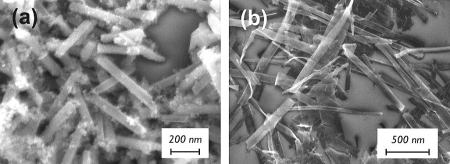 |

| Binding Behavior of Subphthalocyanine-Tagged Testosterone with Human Serum Albumin at the n-Hexane/Water Interface |
K. Adachi, H. Watarai
Anal. Chem., 2006, 78, 6840-6846
DOI : 10.1021/ac060720+
| Abstract: Subphthalocyaninatoboron(III) was applied for the first time as a novel
marker-tag of testosterone (Subpc-test) for the binding analysis with human
serum albumin (HSA) at a liquid/liquid interface. The binding interaction
of Subpc-test with HSA at the n-hexane/water interface was studied by UV−visible absorption and circular
dichroism (CD) spectroscopy combined with a centrifugal liquid membrane
cell at different pHs of aqueous solutions. Complementary studies by a
high-speed stirring experiment and an interfacial tension measurement were
also performed to characterize the interfacial adsorptivity of Subpc-test
and HSA molecules, respectively. The n-hexane solution of Subpc-test showed no optical chirality, but the contact
with the aqueous solution of HSA induced its optical chirality, clearly
suggesting the formation of Subpc-test/HSA complexes at the n-hexane/water interface. Furthermore, pH profiles of CD signals showed that the interaction between Subpc-test and HSA was very sensitive to the neutral-to-base transition (N−B transition). Interfacial formation of the Subpc-test/HSA complex was studied in the presence of the site-selective ligand, furosemide (site I) or cefaclor (site II). The experimental results suggested that Subpc-test is bound to site I of the HSA molecule at the n-hexane/water interface. This technique using subphthalocyanine as a tag molecule and the liquid/liquid interface as a two-dimensional nanoreaction field will be useful for the evaluation of the interaction between drugs or hormones and proteins. |
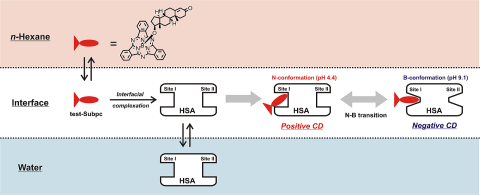 |

| Site-Selective Formation of Optically Active Inclusion Complexes of Alkoxo-Subphthalocyanines with β-Cyclodextrin at the Toluene/Water Interface |
K. Adachi, H. Watarai
Chem. Eur. J., 2006, 12, 4249-4260.
DOI : 10.1002/chem.200501330
| Abstract: Several subphthalocyanine derivatives that contain an alkoxo substituent
as an axial ligand (RO-Subpc, R = 9-anthracenemethyl, benzyl, phenyl, 3,5-dimethylbenzyl,
3,5-dimethylphenyl, 4-methylbenzyl, and 4-methylphenyl) were synthesized.
The formation of inclusion complexes of RO-Subpc with β-CD in DMSO and
at the toluene/water interface was investigated by UV/Vis absorption spectroscopy,
induced circular dichroism (ICD), and nuclear magnetic resonance (NMR)
measurements. Interfacial tension measurements suggested that β-CD adsorbed
as a monolayer at the toluene/water interface and probably orientated towards
the toluene phase with its primary face. The 1:1 composition of β-CD⋅RO-Subpc
inclusion complexes was confirmed in DMSO and at the toluene/water interface
for BzO-Subpc, PhO-Subpc, MeBzO-Subpc, and MePhO-Subpc. A 2:1 inclusion
complex of AnO-Subpc formed in DMSO. The observed ICD spectra of β-CD⋅RO-Subpc
inclusion complexes are discussed with respect to molecular modeling and
the simulation based on Tinoco–Kirkwood theory. Interestingly, the ICD
spectra of β-CD⋅BzO-Subpc and β-CD⋅MeBzO-Subpc inclusion complexes exhibited
a negative sign in DMSO and a positive sign at the toluene/water interface.
This reversal of the ICD sign strongly suggests a difference in the structure
of the inclusion complexes: β-CD at the interface formed the inclusion
complex with its primary face, whereas the secondary face of β-CD bound
favorably to RO-Subpc in DMSO. |
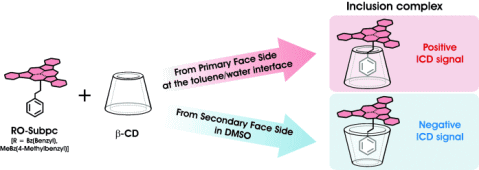 |

| Two-Phase Couette Flow Linear Dichroism Measurement of Shear Forced Orientation of Palladium(II)-Induced Aggregate of Thioether-Derivatised Subphthalocyanines at the Toluene/Glycerol Interface |
K. Adachi, H. Watarai
New J. Chem., 2006, 30, 343-348.
DOI : 10.1039/b517657c
| Abstract: Formation of the Pd(II)-induced thioether-derivatised subphthalocyanine
Subpc(SR)6 (R = Et (ethyl) or Bz (benzyl)) aggregate at the toluene/glycerol interface
was investigated by means of a new in situ spectrophotometric method using
two-phase Couette flow (TPCF). The shear-forced orientation of the aggregate
of Subpc(SR)6–Pd(II) complexes formed at the toluene/glycerol interface was studied
by their linear dichroism (LD) spectra. The H-aggregate of the Subpc(SEt)6–Pd(II) complex gave no LD signal, but the J-aggregate of the Subpc(SBz)6–Pd(II) complex clearly afforded LD spectra at a wide range of rotation speeds, suggesting a longer J-aggregate structure in the Subpc(SBz)6–Pd(II) system. The relaxation kinetics of the shear-forced orientation of the Pd(II)–Subpc(SBz)6 aggregate were observed after stopping the rotation and analysing using a multi-exponential decay equation. By increasing the Subpc(SBz)6 concentration in toluene, the fast relaxation fraction of 6.6–7.5 seconds
decreased and the slow relaxation fraction of 292–322 seconds increased.
The results obtained in this study demonstrate that the TPCF method is
useful for studying the size distribution of aggregates formed at liquid/liquid
interfaces. |
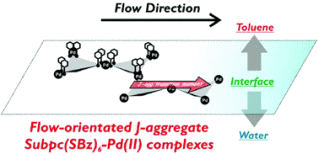 |

| Formation of Helical J-Aggregate of Chiral Thioether-Derivatised Phthalocyanine
Bound by Palladium(II) at the Toluene/Water Interface |
K. Adachi, K. Chayama, and H. Watarai
Langmuir, 2006, 22, 1630-1639
DOI : 10.1021/la0526131
| Abstract: A chiral thioether-substituted phthalocyanine ((2,3,9,10,16,17,23,24-octakis-1-phenylethylthio-
phthalocyaninato) magnesium(II) [MgPc(SEtPh)8]) has been synthesized, which can be bound by soft-metal ions such as
palladium(II) ion. Aggregates formed from MgPc(SEtPh)8 and Pd(II) in toluene and at the toluene/water interface were characterized by means of UV−vis absorption and circular dichroism (CD) spectrometries using centrifugal liquid−membrane (CLM) cell. Matrix-assisted laser desorption ionization time-of-flight mass spectrometry (MALDI-TOF/MS) and scanning electron microscope (SEM) were used as complementary techniques. The toluene solution of MgPc(SEtPh)8 had no optical chirality. However, the addition of PdCl2 into the toluene solution of MgPc(SEtPh)8 induced optical chirality, which indicated the formation of a twisted
H-type dimer (face-to-face fashion) of MgPc(SEtPh)8 bound by four PdCl2 in the bulk toluene solution. On the other hand, in the toluene/water interface, helical J-aggregate (head-to-tail fashion) of MgPc(SEtPh)8 bound by PdCl2 was formed, in which one J-aggregate unit contained five 1:2 complexes
of MgPc(SEtPh)8−Pd(II) on average. On the basis of the experimental results and the exciton
theory for optical chirality, a possible mechanism for the chiral aggregation
of MgPc(SEtPh)8−Pd(II) complexes at the interface was proposed. In the present study,
we demonstrated a novel strategy for the design of helical phthalocyanine
aggregates using the liquid/liquid interface as a template. |
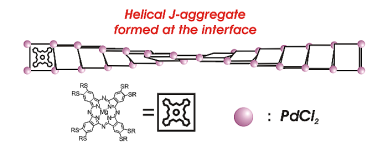 |

<2005> 
| Reduced Formation of Undesirable By-products from the Photocatalytic Degradation of Trichloroethylene |
T. Tanimura, A. Yoshida, S. Yamazaki
Appl. Catal. B: Env., 2005, 61, 346-351
DOI : 10.1016/j.apcatb.2005.05.015
| Abstract: Photocatalytic degradation of trichloroethylene (TCE) was investigated
using a tubular photoreactor packed with TiO2 powders prepared by sol–gel techniques. Powders of the following metals:
Cr, Fe, Ni, Cu and Pt, or Ca(OH)2 were uniformly mixed with the TiO2 powders and then their effect on the formation of COCl2, CHCl3, and CHCl2COCl as by-products was examined. Concentrations of COCl2 and CHCl3 were determined in a product gas stream by GC/MS while CHCl2COCl accumulated on the catalyst surface. When the catalysts were immersed in water after TCE photodegradation, the formation of Cl- and CHCl2COO− ions was confirmed by ion-chromatography. Of the chemicals tested, only
Cu and Ca(OH)2 inhibited the formation of the chlorinated by-products. With increasing
Cu and Ca(OH)2 content, TCE conversion decreased while the stoichiometric ratio ([CO2]formed/[TCE]degraded) increased. Concentrations of COCl2, CHCl3, and CHCl2COCl decreased with increasing Cu and Ca(OH)2 content. Especially, the formation of COCl2 was remarkably suppressed with Ca(OH)2. |
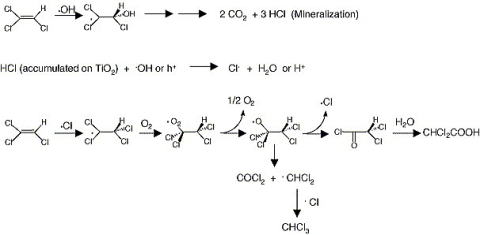 |

| Photocatalytic Degaradation of Chloroform in the Gas Phase on the Porous TiO2 pellets - Effect of Cl accumulated on the Catalyst Surface |
S. Yamazaki, A. Yoshida, H. Abe
J. Photochem. Photobiol. A:Chem., 2005, 169, 191-196
DOI : 10.1016/j.jphotochem.2004.06.018
| Abstract: The photocatalytic degradation of chloroform was studied in a tubular
photoreactor packed with TiO2 pellets prepared by sol–gel method. Concentrations of chloroform and CO2 in the gas stream and Cl− ion which was dissolved from the pellets into water after the photodegradation experiments were detected quantitatively. Chloroform was completely mineralized to CO2 and HCl but the conversion decreased drastically with an increase in the
irradiation time. Such a decrease in the catalytic activity was attributable
to the accumulation of Cl− on the TiO2 surface and was recovered by washing the pellets with water. The presence of Cu and Ca(OH)2 increased the concentration of Cl− accumulated on the surface. The deterioration of the catalytic activity
was suppressed with Ca(OH)2 whereas no appreciable effect was observed with Cu. The TiO2 prepared by sol–gel method exhibited a higher catalytic activity than commercially available Degussa P-25. |
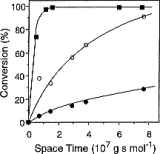 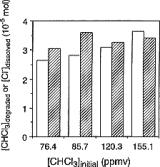 |

| Interfacial Aggregation of Thioether-Substituted Phthalocyaninatomagnesium(II)-Palladium(II) Complexes in the Toluene/Water System |
K. Adachi, H. Watarai
J. Mater. Chem., 2005, 15, 4701-4710 (selected "Hot Articles")
DOI : 10.1039/b509009a
| Abstract: The interfacial aggregation of three thioether-substituted phthalocyanine–magnesium(II)
complexes, MgPc(SR)8, of (2,3,9,10,16,17,23,24-octakis-ethylthiophthalocyaninato)magnesium(II),
[MgPc(SEt)8], (2,3,9,10,16,17,23,24-octakis-benzylthiophthalocyaninato)magnesium(II),
[MgPc(SBz)8], and (2,3,9,10,16,17,23,24-octakis-benzhydrylthiophthalocyaninato)magnesium(II),
[MgPc(SBh)8] were investigated in the toluene/water system by means of
a centrifugal liquid membrane (CLM) method. Aggregation of MgPc(SR)8 molecules at the interface was significantly promoted by the complexation
with soft metal ions such as Pd(II) and Hg(II) added to the aqueous phase.
The interfacial adsorption of MgPc(SEt)8 was caused even in the absence of Pd(II) by the formation of a co-facial
H-dimer, but the presence of Pd(II) promoted H-dimer aggregation at the
interface. In the cases of MgPc(SBz)8 and MgPc(SBh)8, there was observed no significant self-aggregation, but in the presence
of Pd(II), the interfacial aggregation of Pd(II) complexes of MgPc(SBz)8 and MgPc(SBh)8 proceeded remarkably. It was suggested that MgPc(SBz)8–Pd(II) and MgPc(SBh)8–Pd(II) could not form H-aggregates, because of the steric hindrance of
benzyl or bezhydryl group, but they formed J-aggregates. Furthermore, MALDI-TOF/MS
spectra indicated that oligomers of MgPc(SBz)8–Pd(II) complex were formed at the liquid/liquid interface. The present
study demonstrated the first example of Pd(II)-induced interfacial aggregation
of phthalocyanine derivatives at the liquid/liquid interface, and suggested
the possibility of controlling the aggregate structure between H- and J-aggregates
by the size of peripheral substitute groups. |
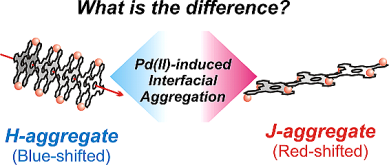 |

| Aggregation of Thioether-Substituted Subphthalocyanines with Palladium(II)
at the Toluene/Water Interface |
K. Adachi, K. Chayama, H. Watarai
Soft Matter, 2005, 1, 292-302 (selected "Hot Articles")
DOI : 10.1039/b508648e
| Abstract: Novel chloro-subphthalocyaninatoboron(III) (Subpc) derivatives with six
thioether at the 2 and 3 positions of peripheral benzene (Subpc(SR)6) such as chloro-[2,3,9,10,16,17-hexakis-ethylthio-subphthalocyaninato]
boron(III) (Subpc(SEt)6) and chloro-[2,3,9,10,16,17-hexakis-benzylthio-subphthalocyaninato] boron(III)
(Subpc(SBz)6) were synthesized. The interfacial adsorption of Subpc and Subpc(SR)6, and the interfacial aggregation of Subpc(SR)6–Pd(II) complexes in the toluene–water system have been investigated by means of high-speed stirring (HSS) spectrometry, centrifugal liquid-membrane (CLM) spectrometry, and matrix-assisted laser desorption/ionization time-of-flight mass spectrometry (MALDI-TOF/MS). Characteristically orientated structures of Subpc(SR)6 molecules and the aggregates of Subpc(SR)6–Pd(II) complexes at the toluene–water interface have been suggested depending
on the structures of Et and Bz at the periphery. The interfacial aggregation
was observed only in the presence of palladium(II), in which one aggregate
unit contained at least seven 1 : 2 complexes of Subpc(SR)6–Pd(II). Interestingly, the absorption spectra of the interfacial aggregates
of Subpc(SEt)6–Pd(II) and Subpc(SBz)6–Pd(II) complexes were very similar to the previously reported spectra of μ-oxo dimer and binuclear molecule of subphthalocyanine, respectively, suggesting the formation of “face-to-face” or H-aggregate for Subpc(SEt)6–Pd(II) and “head-to-tail” or J-aggregate for Subpc(SBz)6–Pd(II), respectively, at the toluene–water interface. |
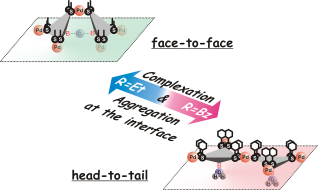 |

<2004> 
| Reaction Mechanism of Photocatalytic Degaradation of Chlorinated Ethylenes
on Porous TiO2 Pellets: Cl radical Initiated Mechanism |
S. Yamazaki, T. Tanimura, A. Yoshida, K. Hori
J. Phys. Chem. A. 2004, 108, 5183-5188
DOI : 10.1021/jp0311310
| Abstract: The photoassisted catalytic degradation of chloroethylene was studied
in a tubular photoreactor packed with TiO2 pellets prepared by a sol−gel method. The experiments were performed in
a noncirculating mode. Kinetic data and the reaction products were compared
with those for the photodegradation of ethylene, trichloroethylene, and
tetrachloroethylene. The theoretical calculations at the MP4/6-31G**//B3LYP/6-31G**
level indicated that the addition of OH radicals to chlorinated ethylenes
is more exothermic than that of Cl radicals by 14.6−29.5 kcal mol-1. Examination of Cl mass balance indicated that the concentration of Cl-
collected from the TiO2 surface was higher than that from the product gas stream. When the photodegradation of ethylene was performed on the TiO2 pellets which had been used for that of TCE or which were pretreated with HCl, the formation of chloroacetaldehyde was confirmed by the GC/MS. We proposed that during the photodegradation of the chlorinated ethylenes, the Cl-, as one of the reaction products, accumulated and was oxidized to Cl radical on the TiO2 surface, which might be due to the oxidation by OH radical. Then, the
Cl radical reacted with chlorinated ethylenes, leading to the formation
of undesirable chlorinated byproducts. |
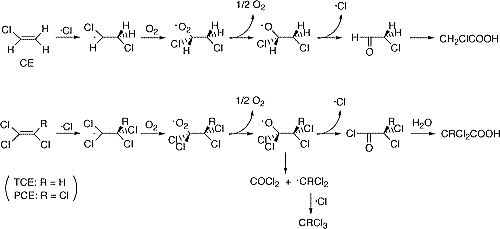 |

| Novel Vermilion/Greenish Blue Electrochromism of PPTA/Iridium Oxide/Au
Thin Films Prepared by Electrodeposition |
J. Yano, K. Noguchi, S. Yamasaki, S. Yamazaki
Electrochem., 2004, 72, 304-309
DOI : 10.1119/1.2746365
| Abstract: We discuss the background associated with an electrochromic device that
can reversibly change its color and optical density at a specific potential.
We discuss the underlying science needed to make a new polyaniline (PAN)/polyvinyl
alcohol (PVA) electrochromic composite film on an indium-tin oxide (ITO)
conducting glass by electropolymerization and describe a reversible redox
transition of the PAN. The experiment gives students an opportunity to
fabricate an electrochromic device containing PAN, one of the most important
conducting polymers. The experimental conditions are flexible so that each
group of students can construct their own electrochromic device with particular
behavior. Two techniques for polymerizing the PAN and three methods of
demonstrating the electrochromism are given, depending on the available
apparatus. A sophisticated three-electrode potentiostat or a crude apparatus
containing a battery, wire, a variable resistor, and a voltage meter is
used to synthesize the PAN deposit. The electrochromic property is repetitively
observed by reversibly changing the applied potentials on the device. A
potentiostatic apparatus, a single flashlight battery, or a flashlight
battery accompanied by a variable resistor allows students to observe multicolor
electrochromism. The experiments significantly enhance students’ understanding
of polymer chemicophysics principles and their appreciation of novel variable
colorful films. The experiments are safe and easy to perform, provided
that appropriate precautions are taken. |

| Novel Color Change of Electrochromic Iridium Oxide in Matrix Aramid Resin Film |
J. Yano, K. Noguchi, S. Yamasaki, S. Yamazaki
Electrochem. Commun., 2004, 6, 110-114
DOI : 10.1016/j.elecom.2003.10.026
| Abstract: An aramid resin, poly(p-phenylene terephtalamide) (PPTA) was precoated
on an ITO electrode as a stable matrix film. Iridium oxide could be electrodeposited
on the electrode because the PPTA film was permeable to dissolved species.
Although the cyclic voltammogram (CV) pattern of the PPTA–iridium oxide
film was almost the same as that of the original iridium oxide film, the
color change differed a little. In the oxidized state, the PPTA–iridium
oxide film showed greenish blue. The XPS-biding energy of Ir 4f5/2 and
Ir 4f7/2 electrons was shifted to about 2 eV higher energy. The maximum
absorption wavelength of the original iridium oxide film was about 650
nm, while that of the PPTA–iridium oxide film was about 600 nm. The color
change was probably due to donating of the lone pair electrons of PPTA
to the indium. The electrodeposition of Au on the PPTA–iridium oxide film
was carried out. The obtained PPTA–iridium oxide–Au film showed quite different
electrochromic properties. New redox current peaks appeared in the CV of
the film. The film was colored vermilion in the reduced state and greenish
blue in the oxidized state. The XPS-biding energy of Ir 4f5/2 and Ir 4f7/2
electrons was shifted to about 2 eV lower energy, implying that the electrodeposition
of Au transformed the electronic state and structure structure of iridium
oxide, suggesting the formation of a -Au-Cl-Ir- binuclear Cl-bridged complex. |
 |
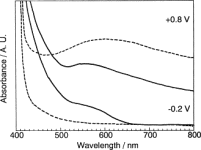 |

| Adsorption Equilibria of Novel Phthalocyaninatomagnesium(II) Derivatives
with Thioethers at the Toluene/Water Interface |
K. Adachi, H. Watarai
Bull. Chem. Soc. Jpn., 2004, 77, 2011-2020
DOI : 10.1246/bcsj.77.2011
| Abstract: Three novel phthalocyaninatomagnesium(II) derivatives with eight peripheral
thioethers (MgPc(SR)8) such as (2,3,9,10,16,17,23,24-octakis-ethylthiophthalocyaninato)magnesium(II)
(MgPc(SEt)8), (2,3,9,10,16,17,23,24-octakis-benzylthiophthalocyaninato)magnesium(II) (MgPc(SBz)8), and (2,3,9,10,16,17,23,24-octakis-benzhydrylthiophthalocyaninato)magnesium(II)
(MgPc(SBh)8) were synthesized. The interfacial adsorption and aggregation behavior
of the three derivatives in a toluene/water system were examined by means
of a high-speed stirring (HSS) method and a centrifugal liquid membrane
(CLM) method. The interfacial adsorption constant of each MgPc(SR)8 derivative at the toluene/water interface was determined by the HSS measurement. Only in the case of MgPc(SEt)8, the formation of the trimer was observed at the interface. Moreover,
the CLM measurements showed that the interfacial aggregate of MgPc(SEt)8 had a new broad band (613 nm) at the blue flank of the Q band (702 nm)
of MgPc(SEt)8 monomer, which might be ascribed to H-aggregate. Extended double-dipole
(EDD) model calculations suggested a cofacially stacked arrangement of
MgPc(SEt)8 molecules in the trimer. The interfacial spectral change indicated that the aggregation of MgPc(SEt)8 at the toluene/water interface proceeded in a two-step, three-stage (monomer
→ dimer → trimer) formation. |
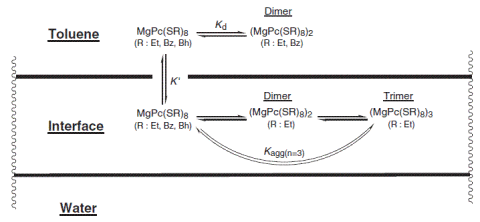 |

|

自動車部材・建材用途を指向した湿気反応性高速硬化型樹脂化合物-シラン架橋ポリオレフィン複合体を中心に-
Crosslinked Polyolefins for Automotive and Housing Sector: Nontoxic and
Efficient Catalysts for Water-Crosslinking Reaction in the Alkoxysilane-Grafted
Polyolefin System |
安達健太
MATERIAL STAGE., 2017, 17, 49-52
Web content : 

山崎鈴子
光化学, 2015, 46, 66-73
| Abstract: Degradation of various pollutants by photocatalysis has been widely studied
over the last 30 years. Titanium dioxide is still the widely used photocatalyst
for environmental remediation because there is no satisfactory alternative.
Sol-gel method is efficient for tailoring nanostructure materials with
high specific surface area without the need for using expensive equipment.
We have developed a synthetic method to prepare porous TiO2 with BET surface area higher than 200 m2 g-1 by using water as solvent and conducting dialysis in the sol-gel method. Recently, many attempts have been devoted to enhance the photocatalytic activity of TiO2 by extending its spectral response to visible light and/or suppressing the recombination of the photogenerated hole and electron. In this review, the preparation of metal-ion-doped TiO2 working under visible light by conducting dialysis in the sol-gel method
and enhancement of the photocatalytic activity obtained by mixing TiO2 and WO3 sol are prepared. |
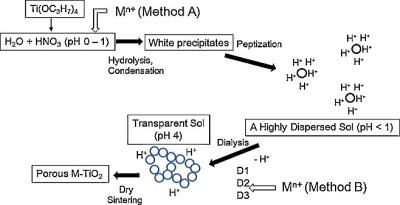 |

| Measuring the Optical Chirality of Molecular Aggregates at Liquid-Liquid
Interfaces |
H. Watarai, K. Adachi
Anal. Bioanal. Chem., 2009, 395, 1033-1046
DOI : 10.1007/s00216-009-3012-5
| Abstract: Some new experimental methods for measuring the optical chirality of molecular
aggregates formed at liquid–liquid interfaces have been reviewed. Chirality
measurements of interfacial aggregates are highly important not only in
analytical spectroscopy but also in biochemistry and surface nanochemistry.
Among these methods, a centrifugal liquid membrane method was shown to
be a highly versatile method for measuring the optical chirality of the
liquid–liquid interface when used in combination with a commercially available
circular dichroism (CD) spectropolarimeter, provided that the interfacial
aggregate exhibited a large molar absorptivity. Therefore, porphyrin and
phthalocyanine were used as chromophoric probes of the chirality of itself
or guest molecules at the interface. A microscopic CD method was also demonstrated
for the measurement of a small region of a film or a sheet sample. In addition,
second-harmonic generation and Raman scattering methods were reviewed as
promising methods for detecting interfacial optical molecules and measuring
bond distortions of chiral molecules, respectively. |
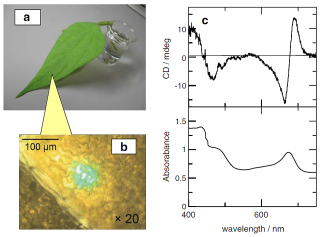 |

| 新規シリカ化合物 -シルセスキオキサンを用いた分離分析技術- |
安達健太
ぶんせき(トピックス), 2009(5), 261-262.

山崎鈴子
ぶんせき(話題欄), 2007(5), 247-248

山崎鈴子
オプトニューズ, 2006, 2(通巻152号), 48-50.

液液界面におけるキラルなフタロシアニン分子集合体の形成
~新規機能性物質の創生を目指して~ |
安達健太, 渡會仁
表面, 2006, 44, 39-59.

山崎鈴子
化学と工業, 2004, 57, 929‐930.

|

河野誠,安達健太
特開2017-015159 (JP 2017-015159)
| 概要: 電極の材料に用いられる粒子の還元のし易さ又は酸化のし易さを1粒子ごとに評価できる分析方法を提供する。本発明に係る分析方法は、電池の電極材料に用いられる粒子pを還元又は酸化させる工程(S202)と、磁場を生成して、還元後又は酸化後の粒子pを磁気泳動させることにより、磁気泳動速度を求める工程(S204)と、磁気泳動速度に基づいて、還元後又は酸化後の粒子pの体積磁化率を求める工程(S206)と、体積磁化率に基づいて、粒子pの還元のし易さ又は酸化のし易さを示すデータを生成する工程(S208)とを包含する。 |

安達健太,山崎鈴子,豊村祥子
特開2015-234907 (JP 2015-234907)
| 概要: 含ケイ素基を有する硬化性樹脂を用いて、危険性、有害性及び環境負荷が小さく、常温において空気中の湿分により極めて速く硬化する硬化性樹脂組成物、及び、かかる硬化性樹脂組成物を含有する湿気硬化型接着剤、シーリング材を得ること。加水分解性シリル基を有する硬化性樹脂(A);金属錯体(a)に塩基性化合物(b)が配位した複合錯体(B);を含有することを特徴とする硬化性樹脂組成物は、有機錫化合物を用いることがないため、危険性、有害性及び環境負荷が小さく、常温において空気中の湿分により極めて速く硬化する硬化性樹脂組成物である。 |

遷移金属酸化物及び水溶性高分子化合物を含有する複合膜
Transition metal oxide/water-soluble macromolecule/water-soluble compound
composite membranes, photochromic films, recording media, and blue photographic
materials using them |
山崎鈴子, 安達健太, 石田裕貴
特開2014-062218 (JP 2014062218)
概要: フォトクロミズムを示す複合膜であって、成膜性、暗下での透明性に優れ、且つ、光照射により高い遮光性を示す調光フィルム等として利用できる複合膜を提供する。複合膜は、遷移金属酸化物、水溶性高分子化合物、及びヒドロキシ基を有する水溶性化合物(ただし、前記水溶性高分子化合物を除く)を含有する。遷移金属酸化物としては、酸化タングステンが好ましく、水溶性高分子化合物としてはメチルセルロース等のアルキルセルロースが好ましく、ヒドロキシ基を有する水溶性化合物としては、エチレングリコールやグリセリン等のアルコール類や、シュウ酸やグリコール酸等の有機酸類が好ましい。本発明の複合膜は、紫外線の照射によって発色するため、調光フィルム、記録媒体、青写真(日光写真)用感光体等として有用である。
Abstract: The title composite membranes contain transition metal oxides (e.g., WO3), water-solution macromolecules (e.g., alkylcelluloses), and water-solution compounds (e.g., alcohols., organic acids). The composite membranes are transparent under
room light, and develop blue by UV irradation to have light shield 99%. |
 |

|

Suzuko Yamazaki, Daisuke Takaki, Naoto Nishiyama, Yukari Yamazaki,
Chapter 3: Facters affecting Photocatalytic activity of TiO2,
In Current Developments in Photocatalysis and Photocatalytic Materials - New
Horizons in Photocatalysis, edited by X. Wang, M. Anpo and X. Fu, Elsevier, 2019, pp. 23-38.
|
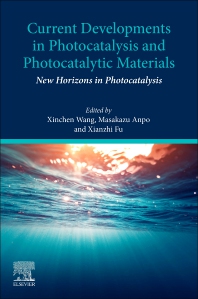 |

山崎鈴子 7.1.3 「光化学スモッグ」
「光化学の事典」(編集:光化学協会光化学の事典編集委員会)朝倉書店 (2014) |
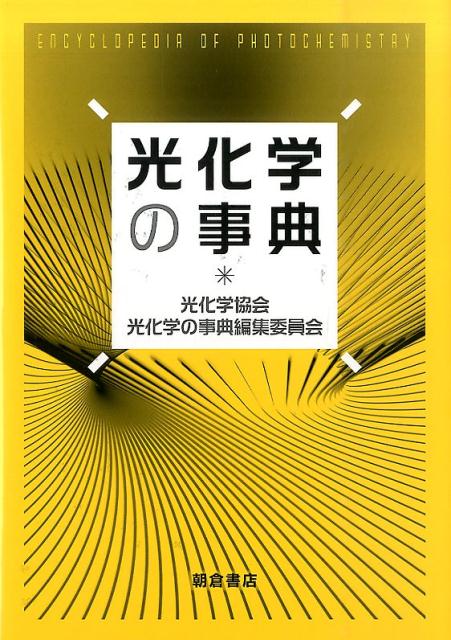 |

安達健太, 山崎鈴子 第4章 光応用 「WO3フォトクロミズムとその応用」
「ゾル-ゲル法の最新応用と展望」(監修:野上正行) シーエムシー出版 (2014) |
 |

| 斉藤勝裕, 山崎鈴子著 「わかる化学シリーズ6 環境化学」 東京化学同人 (2007) |
 |

山崎鈴子 第9章 土壌浄化 「揮発性有機塩素化合物の光触媒分解」
「光触媒~基礎・材料開発・応用~」(監修:橋本和仁, 大谷文章, 工藤昭彦) エヌ・ティー・エス (2005) |
 |

| 堀憲次, 山崎鈴子 「計算化学実験」 丸善 (1998) |
 |

|
|
|

